*NURSING > HESI > HESI Critical Care Comprehensive Exam1 | Latest Questions and Complete Solutions | GRADED A (All)
HESI Critical Care Comprehensive Exam1 | Latest Questions and Complete Solutions | GRADED A
Document Content and Description Below
Critical Care Comprehensive Exam 1 1. A client with asthma receives a prescription for high blood pressure during a clinic visit. Which prescription should the nurse anticipate the client to receiv... e that is least likely to exacerbate asthma? A. Carteolol (Ocupress). B. Propranolol hydrochloride (Inderal). C. Pindolol (Visken). Incorrect D. Metoprolol tartrate (Lopressor). Correct The best antihypertensive agent for clients with asthma is metoprolol (Lopressor) (C), a beta2 blocking agent which is also cardioselective and less likely to cause bronchoconstriction. Pindolol (A) carteolol (B) is a beta blocking agent and an effective antihypertensive agent used in managing angina, it can increase a client's risk for bronchoconstriction due to its nonselective beta blocker action. Propranolol (D) also blocks the beta2 receptors in the lungs, causing bronchoconstriction, and is not indicated in clients with asthma and other obstructive pulmonary disorders. 2. A male client who has been taking propranolol (Inderal) for 18 months tells the nurse that the healthcare provider discontinued the medication because his blood pressure has been normal for the past three months. Which instruction should the nurse provide? A. Obtain another antihypertensive prescription to avoid withdrawal symptoms. B. Stop the medication and keep an accurate record of blood pressure. C. Report any uncomfortable symptoms after stopping the medication. D. Ask the healthcare provider about tapering the drug dose over the next week. Correct Although the healthcare provider discontinued the propranolol, measures to prevent rebound cardiac excitation, such as progressively reducing the dose over one to two weeks (C), should be recommended to prevent rebound tachycardia, hypertension, and ventricular dysrhythmias. Abrupt cessation (A and B) of the beta-blocking agent may precipitate tachycardia and rebound hypertension, so gradual weaning should be recommended. (D) is not indicated. 3. A client who is taking clonidine (Catapres, Duraclon) reports drowsiness. Which additional assessment should the nurse make? A. Has the client experienced constipation recently? B. Did the client miss any doses of the medication? C. How long has the client been taking the medication? Correct D. Does the client use any tobacco products? Drowsiness can occur in the early weeks of treatment with clonidine and with continued use becomes less intense, so the length of time the client has been on the medication (A) provides 4.ID: 6974873590 The nurse is preparing to administer atropine, an anticholinergic, to a client who is scheduled for a cholecystectomy. The client asks the nurse to explain the reason for the prescribed medication. What response is best for the nurse to provide? A. Provide a more rapid induction of anesthesia. B. Induce relaxation before induction of anesthesia. C. Decrease the risk of bradycardia during surgery. Correct D. Minimize the amount of analgesia needed postoperatively. Atropine may be prescribed preoperatively to increase the automaticity of the sinoatrial node and prevent a dangerous reduction in heart rate (B) during surgical anesthesia. (A, C and D) do not address the therapeutic action of atropine use perioperatively. 5.ID: 6974876286 An 80-year-old client is given morphine sulphate for postoperative pain. Which concomitant medication should the nurse question that poses a potential development of urinary retention in this geriatric client? A. Antacids. B. Tricyclic antidepressants. Correct C. Nonsteroidal antiinflammatory agents. D. Insulin. Drugs with anticholinergic properties, such as tricyclic antidepressants (C), can exacerbate urinary retention associated with opioids in the older client. Although tricyclic antidepressants and antihistamines with opioids can exacerbate urinary retention, the concurrent use of (A and B) with opioids do not. Nonsteroidal antiinflammatory agents (D) can increase the risk for bleeding, but do not increase urinary retention with opioids (D). 6.ID: 6974873559 A client with osteoarthritis is given a new prescription for a nonsteroidal antiinflammatory drug (NSAID). The client asks the nurse, "How is this medication different from the acetaminophen I have been taking?" Which information about the therapeutic action of NSAIDs should the nurse provide? A. Are less expensive. B. Provide antiinflammatory response. Correct C. Increase hepatotoxic side effects. D. Cause gastrointestinal bleeding. Nonsteroidal antiinflammatory drugs (NSAIDs) have antiinflammatory properties (B), which relieves pain associated with osteoarthritis and differs from acetaminophen, a non-narcotic analgesic and antipyretic. (A) does not teach the client about the medication's actions. Although NSAIDs are food in the stomach to manage this as an expected side effect should be included, but this does not answer the client's question. Acetaminophen is potentially hepatotoxic (D), not NSAIDs. 7.ID: 6974876262 A client with cancer has a history of alcohol abuse and is taking acetaminophen (Tylenol) for pain. Which organ function is most important for the nurse to monitor? A. Cardiorespiratory. B. Liver. Correct C. Sensory. D. Kidney. Acetaminophen and alcohol are both metabolized in the liver. This places the client at risk for hepatotoxicity, so monitoring liver (A) function is the most important assessment because the combination of acetaminophen and alcohol, even in moderate amounts, can cause potentially fatal (NSAIDs), are more likely to promote adverse renal effects (B). Acetaminophen does not place the client at risk for toxic reactions related to (C or D). 8.ID: 6974875110 The nurse obtains a heart rate of 92 and a blood pressure of 110/76 prior to administering a scheduled dose of verapamil (Calan) for a client with atrial flutter. Which action should the nurse implement? A. Give intravenous (IV) calcium gluconate. B. Withhold the drug and notify the healthcare provider. C. Administer the dose as prescribed. Correct D. Recheck the vital signs in 30 minutes and then administer the dose. Verapamil slows sinoatrial (SA) nodal automaticity, delays atrioventricular (AV) nodal conduction, which slows the ventricular rate, and is used to treat atrial flutter, so (A) should be implemented, based on the client's heart rate and blood pressure. (B and C) are not indicated. (D) delays the administration of the scheduled dose. 9.ID: 6974873583 A client is admitted to the hospital with a diagnosis of Type 2 diabetes mellitus and influenza. Which categories of illness should the nurse develop goals for the client's plan of care? A. One chronic and one acute illness. Correct B. Two acute illnesses. C. One acute and one infectious illness. Incorrect D. Two chronic illnesses. The plan of care should include goals that are specific for chronic and acute illnesses. Adult-onset diabetes is a life-long chronic disease, whereas influenza is an acute illness with a short term duration (C). (A, B, and D) do not include the correct duration categories for this situation. 10.ID: 6974877914 Following an emergency Cesarean delivery, the nurse encourages the new mother to breastfeed her newborn. The client asks why she should breastfeed now. Which information should the nurse provide? A. Stimulate contraction of the uterus. Correct B. Initiate the lactation process. C. Facilitate maternal-infant bonding. D. Prevent neonatal hypoglycemia. When the infant suckles at the breast, oxytocin is released by the posterior pituitary to stimulates the "letdown" reflex, which causes the release of colostrum, and contracts the uterus (C) to prevent uterine hemorrhage. (A and B) do not support the client's need in the immediate period after the emergency delivery. Although maternal-newborn bonding (D) is facilitated by early breastfeeding, the priority is uterine contraction stimulation. 11.ID: 6974875104 Which intervention should the nurse include in the plan of care for a female client with severe postpartum depression who is admitted to the inpatient psychiatric unit? A. Restrict visitors who irritate the client. B. Full rooming-in for the infant and mother. C. Supervised and guided visits with infant. Correct D. Daily visits with her significant other. Structured visits (C) provide an opportunity for the mother and infant to bond and should be facilitated and encouraged according to the client's pace of progress. (A) is unrealistic and may not be safe for the baby or the client. (B) is an unrealistic expectation. Although daily visits may provide support, the significant other may not be able to be there every day (D) based on other family responsibilities. 12.ID: 6974873535 A 16-year-old male client is admitted to the hospital after falling off a bike and sustaining a fractured bone. The healthcare provider explains the surgery needed to immobilize the fracture. Which action should be implemented to obtain a valid informed consent? A. Obtain the permission of the custodial parent for the surgery. Correct B. Notify the non-custodial parent to also sign a consent form. C. Instruct the client sign the consent before giving medications. D. Obtain the signature of the client’s stepfather for the surgery. Incorrect The client is a minor and cannot legally sign his own consent unless he is an emancipated minor, so the consent should be obtained from the guardian for this client, which is the custodial parent (B). (A) adopted by the stepparent (C). The non-custodial parent does not need to co-sign this form (D). 13.ID: 6974876258 During a client assessment, the client says, "I can't walk very well." Which action should the nurse implement first? A. Predict the likelihood of the outcome. B. Consider alternatives. C. Choose the most successful approach. D. Identify the problem. Correct The sequential steps in problem-solving are to first identify the problem (B), then consider alternatives (C), consider outcomes of the alternatives (D), predict the likelihood of the outcomes occurring, and choose the alternative with the best chance of success (A). 14.ID: 6974875112 The nurse identifies a client's needs and formulates the nursing problem of, "Imbalanced nutrition: less than body requirements, related to mental impairment and decreased intake, as evidenced by increasing confusion and weight loss of more than 30 pounds over the last 6 months." Which short- term goal is best for this client? A. Verbalize understanding of plan and of intention to eat meals. B. Eat 50% of six small meals each day by the end of one week. Correct C. Meals prepared during hospitalization will be fed by the nurse. D. Demonstrate progressive weight gain toward the ideal weight. Short-term goals should be realistic and attainable and should have a timeline of 7 to 10 days before discharge. (A) meets those criteria. (B) is nurse-oriented. (C) may be beyond the capabilities of a confused client. (D) is a long-term goal. 15.ID: 6974873569 A male client is angry and is leaving the hospital against medical advice (AMA). The client demands to take his chart with him and states the chart is "his" and he doesn' t want any more contact with the hospital. How should the nurse respond? A. This hospital does not need to keep it if you are leaving and not returning here. B. Because you are leaving against medical advice, you may not have your chart. C. The information in your chart is confidential and cannot leave this facility legally. D. The chart is the property of the hospital but I will see that a copy is made for you. Correct The chart is the property of the facility, but the client has a legal right to the information in it, even if he is leaving AMA, so a copy of the record (D) should be provided. The client does not lose his legal rights to his medical record if he leaves AMA (A). The medical record is confidential, but the hospital protects the client's privacy by not allowing unauthorized access to the record, so the hospital may provide the client with a copy (B). The hospital must maintain records of the care provided and should not release the original record (C). 16.ID: 6974877906 The nurse manager is assisting a nurse with improving organizational skills and time management. Which nursing activity is the priority in pre-planning a schedule for selected nursing activities in the daily assignment? A. Tracheostomy tube suctioning. Incorrect B. Medication administration. Correct C. Colostomy care instruction. D. Client personal hygiene. In developing organizational skills, medication administration is based on a prescribed schedule that activities in a daily assignment. Although suctioning a client's tracheostomy takes precedence in providing care, the client's PRN need is less amenable to a preselected schedule. (B and C) can be scheduled around time-sensitive delivery of care. 17.ID: 6974876220 What nursing delivery of care provides the nurse to plan and direct care of a group of clients over a 24-hour period? A. Case management. B. Team nursing. Incorrect C. Primary nursing. Correct D. Functional nursing. Primary nursing (B) is a model of delivery of care where a nurse is accountable for planning care for clients around the clock. Functional nursing (D) is a care delivery model that provides client care by assignment of functions or tasks. Team nursing (A) is a care delivery model where assignments to a group of clients are provided by a mixed-staff team. Case management (C) is the delivery of care that uses a collaborative process of assessment, planning, facilitation, and advocacy for options and services to meet an individual's health needs and promote quality cost-effective outcomes. 18.ID: 6974876280 Two unlicensed assistive personnel (UAP) are arguing on the unit about who deserves to take a break first. What is the most important basic guideline that the nurse should follow in resolving the conflict? A. Require the UAPs to reach a compromise. B. Weigh the consequences of each possible solution. Incorrect C. Encourage the two to view the humor of the conflict. D. Deal with issues and not personalities. Correct Dealing with the issues which are concrete, not personalities (A) which include emotional reactions, conflict when diverse opinions are expressed emotionally. 19.ID: 6974873531 The nurse is caring for a client who is unable to void. The plan of care establishes an objective for the client to ingest at least 1000 mL of fluid between 7:00 am and 3:30 pm. Which client response should the nurse document that indicates a successful outcome? A. Demonstrates adequate fluid intake and output. B. Verbalizes abdominal comfort without pressure. C. Drinks 240 mL of fluid five times during the shift. Correct D. Voids at least 1000 mL between 7 am and 3 pm. The nurse should evaluate the client's outcome by observing the client's performance of each expected behavior, so drinking 240 mL of fluid five or six times during the shift (D) indicates a fluid period. (A) uses the term "adequate," which is not quantified. (B) is not the objective, which establishes an intake of at least 1000 mL. (C) is not an evaluation of the specific fluid intake. 20.ID: 6974873553 The nurse plans a teaching session with a client but postpones the planned session based on which nursing problem? A. Knowledge deficit regarding impending surgery. B. Ineffective management of treatment regimen. C. Activity intolerance related to postoperative pain. Correct D. Noncompliance with prescribed exercise plan. Pain, fatigue, or anxiety can interfere with the ability to pay attention and participate in learning, so the nursing diagnosis in (A) indicates a need to postpone teaching. (B, C, and D) indicate a need for 21.ID: 6974875106 A client who has active tuberculosis (TB) is admitted to the medical unit. What action is most important for the nurse to implement? A. Fit the client with a respirator mask. B. Assign the client to a negative air-flow room. Correct C. Don a clean gown for client care. D. Place an isolation cart in the hallway. Active tuberculosis requires implementation of airborne precautions, so the client should be assigned to a negative pressure air-flow room (D). Although (A and C) should be implemented for clients in isolation with contact precautions, it is most important that air flow from the room is minimized when the client has TB. (B) should be implemented when the client leaves the isolation environment. 22.ID: 6974873585 A client is receiving atenolol (Tenormin) 25 mg PO after a myocardial infarction. The nurse determines the client's apical pulse is 65 beats per minute. What action should the nurse implement next? A. Measure the blood pressure. B. Reassess the apical pulse. C. Notify the healthcare provider. D. Administer the medication. Correct Atenolol, a beta-blocker, blocks the beta receptors of the sinoatrial node to reduce the heart rate, so the medication should be administered (C) because the client's apical pulse is greater than 60. (A, B, and D) are not indicated at this time. 23.ID: 6974875175 The nurse is assessing a client and identifies a bruit over the thyroid. This finding is consistent with which interpretation? A. Hypothyroidism. B. Thyroid cyst. C. Thyroid cancer. D. Hyperthyroidism. Correct Hyperthyroidism (D) is an enlargement of the thyroid gland, often referred to as a goiter, and a bruit may be auscultated over the goiter due to an increase in glandular vascularity which increases as the thyroid gland becomes hyperactive. A bruit is not common with (A, B, and C). 24.ID: 6974876270 A 6-year-old child is alert but quiet when brought to the emergency center with periorbital ecchymosis and ecchymosis behind the ears. The nurse suspects potential child abuse and continues to assess the child for additional manifestations of a basilar skull fracture. What assessment finding would be consistent with a basilar skull fracture? A. Hematemesis and abdominal distention. B. Asymmetry of the face and eye movements. C. Rhinorrhoea or otorrhoea with Halo sign. Correct D. Abnormal position and movement of the arm. Raccoon eyes (periorbital ecchymosis) and Battle's sign (ecchymosis behind the ear over the mastoid process) are both signs of a basilar skull fracture, so the nurse should assess for possible meningeal tears that manifest as a Halo sign with CSF leakage from the ears or nose (D). (A) is consistent with orbital fractures. (B) occurs with wrenching traumas of the shoulder or arm fractures. (C) occurs with blunt abdominal injuries. 25.ID: 6974873555 The nurse is assessing a client who complains of weight loss, racing heart rate, and difficulty sleeping. The nurse determines the client has moist skin with fine hair, prominent eyes, lid retraction, and a staring expression. These findings are consistent with which disorder? A. Grave's disease. Correct B. Multiple sclerosis. C. Addison's disease. D. Cushing syndrome. This client is exhibiting symptoms associated with hyperthyroidism or Grave's disease (A), which is an autoimmune condition affecting the thyroid. (B, C, and D) are not associated with these symptoms. 26.ID: 6974875146 The nurse is assessing an older client and determines that the client's left upper eyelid droops, covering more of the iris than the right eyelid. Which description should the nurse use to document this finding? A. A nystagmus on the left. B. Exophthalmos on the right. C. Ptosis on the left eyelid. Correct D. Astigmatism on the right. Ptosis is the term to describe an eyelid droop that covers a large portion of the iris (A), which may result from oculomotor nerve or eyelid muscle disorder. (B) is characterized by rapid, rhythmic movement of both eyes. (C) is a distortion of the lens of the eye, causing decreased visual acuity. (D) is a term used to describe a protrusion of the eyeballs that occurs with hyperthyroidism. 27.ID: 6974875126 The nurse is assessing a child's weight and height during a clinic visit prior to starting school. The nurse plots the child's weight on the growth chart and notes that the child's weight is in the 95th percentile for the child's height. What action should the nurse take? A. Question the type and quantity of foods eaten in a typical day. Correct B. Encourage giving two additional snacks each day to the child. C. Recommend a daily intake of at least four glasses of whole milk. D. Assess for signs of poor nutrition, such as a pale appearance. The child is overweight for height, so assessment of the child's daily diet (C) should be determined. The child does not need (A or B), both of which will increase the child's weight. Poor nutrition (D) is commonly seen in underweight children, not overweight. 28.ID: 6974876202 A child is receiving maintainance intravenous (IV) fluids at the rate of 1000 mL for the first 10 kg of body weight, plus 50 mL/kg per day for each kilogram between 10 and 20. How many milliliters per hour should the nurse program the infusion pump for a child who weighs 19.5 kg? (Enter numeric value only. If rounding is required, round to the nearest whole number.) A. 24 Incorrect B. 61 Correct C. 73 D. 58 The formula for calculating daily fluid requirements is: 0 to 10 kg, 100 mL/kg per day; or 10 to 20 kg, 1000 mL for the first 10 kg of body weight plus 50 mL/kg per day for each kilogram between 10 and 20. To determine an hourly rate, divide the total milliliters per day by 24. 19.5 kg x 50 mL/kg = 475 mL + 1000 mL = 1475 mL / 24 hours = 61 mL/hour 29.ID: 6974877920 The nurse obtains the pulse rate of 89 beats/minute for an infant before administering digoxin (Lanoxin). Which action should the nurse take? A. Withhold the medication and contact the healthcare provider. Correct B. Give the medication dosage as scheduled. C. Assess respiratory rate for one minute next. D. Wait 30 minutes and give half of the dosage of medication. Bradycardia is an early sign of digoxin toxicity, so if the infant's pulse rate is less than 100 beats/minute, digoxin should be withheld and the healthcare provider should be notified (D). Assessing the respiratory rate (A) is not indicated before administering Lanoxin. (B and C) place the 30.ID: 6974873567 The nurse is developing a teaching plan for an adolescent with a Milwaukee brace. Which instruction should the nurse include? A. Wear the brace over a T-shirt 23 hours per day. Correct B. Dress with the brace over regular clothing. C. Shower with the brace directly against the skin. D. Remove the brace just before going to bed. Idiopathic scoliosis is an abnormal lateral curvature of the spine in adolescent females. Early treatment uses a Milwaukee brace that places pressure against the lateral spinal curvature, under the neck, and against the iliac crest, so it should be worn for 23 hours per day over a T-shirt (D) which reduces friction and chafing of the skin. (A, B, and C) reduce the effectiveness of the brace. 31.ID: 6974873594 A 9-year-old is hospitalized for neutropenia and is placed in reverse isolation. The child asks the nurse, "Why do you have to wear a gown and mask when you are in my room?" How should the nurse respond? A. “To protect you because you can get an infection very easily.” Correct B. "Your condition could be spread to staff and other clients in the hospital.” C. “There are many forms of bacteria and germs in the hospital.” D. “After taking medication for 24 hours a gown and mask won't be needed.” Reverse isolation precaution implement measures to protect the client from exposure to microorganisms from others (B). Although microbes are prevalent in all environments, (A) does not adequately answer the child's question. Reverse isolation should be implemented until the client's white blood cell increases (C). Neutropenia in this child does not place others (D) at risk for infection. 32.ID: 6974876230 The nurse is giving discharge instructions to the parents of a newborn with a prescription for home phototherapy. Which statement by a parent indicates understanding of the phototherapy? A. “I should leave the baby under the light all of the time.” B. “I should dress the baby in light clothing when the baby is under the light.” C. “I need to change the baby’s position every four hours.” D. “I will keep the baby’s eyes covered when the baby is under the light.”Correct Neonatal jaundice is related to subcutaneous deposition of fat-soluble (indirect) bilirubin, which is converted to a water-soluble form when the skin is exposed to an ultraviolet light, so the infant's eyes should be protected (C) by closing the eyes and placing patches over them before placing the baby under the phototherapy light source. The baby's position should be changed about every two hours, not (A), so that the light reaches all areas of the body to promote conversion to a water-soluble form of bilirubin, which is excreted in the urine. The infant can be removed from the light for feedings and diaper changes, but should receive phototherapy exposure for 18 hours a day (B). The baby should be naked or dressed in only a diaper to expose as much skin as possible to the light (D). 33.ID: 6974876242 A male client who had abdominal surgery has a nasogastric tube to suction, oxygen per nasal cannula, and complains of dry mouth. Which action should the nurse implement? A. Apply a water soluble lubricant to the lips, oral mucosa and nares.Correct B. Put petroleum jelly on the lips and around the nasogastric tube. C. Offer the client ice chips and instruct client to spit out the water. D. Allow the client to drink water and record on the I and O record. To ease the client's discomfort, a water soluble lubricant to the lips and nares assists to keep the mucous membranes moist (D). (A) is a petroleum-based product and should not be used because it 34.ID: 6974877904 The nurse is assessing the laboratory results for a client who is admitted with renal failure and osteodystrophy. Which findings are consistent with this client's clinical picture? A. Hemoglobin of 10 g and hypophosphatemia. B. Cloudy, amber urine with sediment, specific gravity of 1.040. C. Serum potassium of 5.5 mEq and total calcium of 6 mg/dl. Correct D. Blood urea nitrogen 40 m and creatinine 1.0. In renal failure, normal serum electrolyte balance is altered because the kidneys fail to activate vitamin D, calcium absorption is impaired, and serum calcium decreases, which stimulates the release of PTH causing resorption of calcium and phosphate from the bone. A decreased tubular excretion and a decreased glomerular filtration rate results in hypocalcemia, hyperphosphatemia, and hyperkalemia (C). (A) is reflective of a non-renal cause, such as dehydration or liver pathology. (B) is more indicative of infection. Renal failure causes anemia and hyperphosphatemia, not (D). 35.ID: 6974875190 Which information should the nurse give a client with chronic kidney disease (CKD)? A. Obtain monthly B12 injections. B. Restrict calcium-rich foods. C. Avoid salt substitutes. Correct D. Increase daily intake of fiber. A client with CKD should restrict sodium and potassium dietary intake, and salt substitutes usually contain potassium, so (C) should be taught. Hypocalcemia is a complication of CKD and calcium supplements are often needed, not (A). Anemia related to CKD is treated with iron, folic acid, and erythropoietin, not (B). Although (D) is a common dietary recommendation, it not an essential part of client teaching for CKD. 36.ID: 6974877916 A nurse is answering questions about breast cancer at a hospital-sponsored community health fair. A woman asks the nurse to explain the use of tamoxifen (Nolvadex). Which response should the nurse provide? A. Part of a combination of chemotherapeutic agents used to treat tumors. B. An used to reduce the risk of breast cancer for all women. C. Low doses of tamoxifen prevent menopausal hot flashes. D. This anti-estrogen drug inhibits malignancy growth. Correct Tamoxifen (Nolvadex) is used in postmenopausal women with breast cancer to prevent and treat recurrent cancer and inhibit the growth-stimulating effects (C) of estrogen by blocking estrogen receptor sites on malignant cells. A side effect of tamoxifen is hot flashes (A), which is related to the decreased estrogen. Tamoxifen is used for women with estrogen receptor-positive breast cancer, not all women (B), and is classified as a hormonal agent, not (D), used to suppress malignant cell growth. 37.ID: 6974875118 A 56-year-old female client is receiving intracavitary radiation via a radium implant. Which nurse should be assigned to care for this client? A. The nurse who is caring for another client receiving intracavitary radiation. B. A nurse with Marfan's syndrome who is postmenopausal. Correct C. A nurse with oncology experience who may be pregnant. D. The nurse who is caring for another client who has Clostridium difficile. A client receiving intracavity radiation poses a radiation hazard as long as the intracavity radiation source is in place. A nurse's ability to care of this client is not affected by Marfan's syndrome (B), which is a hereditary disorder of connective tissues, bones, muscles, ligaments and skeletal structures. The goal is to limit any one staff member's exposure to the calculated time span based on the half-life of radium, such as the number of minutes at the bedside per day, so (A) should not be assigned. (C) should not be exposed to the radiation due to the possible effect on the fetus. A radiation exposure decreases the immune response in the client who should not be exposed to the potential inadvertent transmission of an infectious organism (D). 38.ID: 6974873561 Which information should the nurse provide a client who has undergone cryosurgery for Stage 1A cervical cancer? A. Use condoms for sexual intercourse during the next week. B. Notify the healthcare provider if heavy vaginal discharge occurs. C. Use a sanitary napkin instead of a tampon. Correct D. Flat subclinical mucosal lesions are a common harmLess side effect. Clients should avoid the use of tampons for 3 to 6 weeks (D) after the procedure to reduce the risk of Sexual intercourse should be avoided for up to 6 weeks, so (B) is inaccurate. (C) is not a side effect of the procedure but may indicate human papillomavirus or a cancerous lesion and should be reported. 39.ID: 6974873525 Which nurse follows a client from admission through discharge or resolution of illness and coordinates the client's care between healthcare providers? A. Case manager. Correct B. Nurse-manager. C. Discharge manager. D. Quality manager. The role of the case manager (A) is to assist the continuum of care for the client, and coordinate the plan of care, evaluate client needs, and collaborate with the interdisciplinary healthcare team to ensure that goals are met, quality is maintained, and progress toward discharge is made. (B) focuses on staffing and assigning work on client units. (C) reviews research and assesses opportunities for process improvement, implement changes, measure outcomes, and start the discharge but would not be involved with client admission activities. 40.ID: 6974875196 The nurse is preparing a client for a scheduled surgical procedure. What client statement should the nurse report to the healthcare provider? A. Expresses fear about the surgical procedure. B. Reports a history of hives after eating shellfish. C. States has a history of post-operative nausea. D. Recalls drinking a glass of juice after midnight. Correct The risk of aspiration while under general anesthesia is increased when the stomach is not empty prior to a surgical procedure, so the client's intake of juice (B) after midnight should be reported the healthcare provider. Preoperative fear and anxiety (A) are common and should be further explored by the nurse. (C) should be communicated using allergy identification tags on the client's records and bracelets on the client's wrist. (D) is a common and expected side effect of perioperative medications. 41.ID: 6974873596 The parents of a 14-year-old boy express concern about their son's behavior, which ranges from clean-cut and personable to "grungy" and sullen. They have tried talking with him and disciplining him, but he continues to demonstrate confusing behaviors. Which information is best for the nurse to provide? A. Rebelliousness requires consequences to prevent socially deviant behavior. B. The parents should consider hospitalization to prevent self injury. C. Adolescents who demonstrate labile behaviors are at risk for self-injury. D. Early adolescence is a developmental stage of normal experimentation.Correct The nurse should support the parents by explaining that early adolescence is a developmental change spurred by hormonal increases in pubescence and teenage experimentation with values, choices, and peer acceptance (C). (A, B, and D) are not applicable in the context of this adolescent's behavior. 42.ID: 6974877902 The nurse is interviewing a female client whose spouse is present. During the interview, the spouse answers most of the questions for the client. Which action is best for the nurse to implement? A. Direct the questions to the spouse whenever possible. B. Ask another nurse to complete the interview. C. Ask the spouse to step out for a few minutes. Correct D. Repeat each question and tell the client to speak up. The nurse should ask the spouse to step out of the room (D), which maintains the client's privacy and allows the client to respond, without confronting the spouse. (A) reinforces the spouse's responses. (B) may not eliminate the spouse's responses on behalf of the client. (C) does not foster the nurse-client relationship. 43.ID: 6974875184 The nurse determines that a client's body weight is 105% above the standardized height-weight scale. Which related factor should the nurse include in the nursing problem, "Imbalanced nutrition: more than body requirements?" A. Markedly obese. B. Inadequate lifestyle changes in diet and exercise. Correct C. Morbidly obese. D. Increased morbidity and mortality risks. Obesity is a body weight that is 20% above desirable weight for a person's age, sex, height, body build, and calculated body mass index (BMI). (C) best identifies factors that contribute to the formulation of the nursing diagnosis. (A and B) are medical classifications for a client's weight. Although the client is at an increased risk for several chronic illnesses (D), such as heart disease, diabetes mellitus, hypertension, coronary artery disease and hyperlipidemia, this is not a contributing cause or related factor that supports the nursing diagnosis. 44.ID: 6974876234 The nurse is assessing a client and identifies the presence of petechiae. Which documentation best describes this finding? A. Purplish-red pinpoint lesions of the skin. Correct B. Generalized reddish discoloration of an area of skin. C. Small circumscribed elevations containing purulent fluid. D. Purple to bluish discoloration of the skin. Petechiae are described as purplish to red, non-blanchable, pinpoint lesions (A) that are tiny hemorrhages within the dermal or submucosal layers. (B) describes ecchymosis caused by trauma to the underlying blood vessels. (C) describes pustules. (D) is nonspecific and incomplete. 45.ID: 6974876214 The nurse is inspecting the external eye structures for a client. Which finding is a normal racial variation? A. A Hispanic client may have inward-turned eyelashes. B. A Caucasian client may have a slightly protruding eyeball. C. An African-American client may have slightly yellow sclerae. Correct D. An Asian client may have a horizontal palpebrale fissure. Recognizing normal variations that are common in different racial groups helps the nurse differentiate an early sign of pathology, such as yellow sclerae. A slightly yellow color of the sclera for (C) is a normal racial variation found in the African-American population. (A, B, and D) are findings not related to one racial group. 46.ID: 6974875194 During the physical assessment, which finding should the nurse recognize as a normal finding? A. Jugular venous pressure palpable with the client in an upright position. B. Point of maximal impulse at the third intercostal space in the right midclavicular line. C. Apical pulse noted over an area 4 to 5 centimeters with a duration of 2 seconds. D. Regular pulsation at the epigastric area when the client is supine.Correct Recognizing normal findings in the physical exam is a necessity. The regular and recurrent expansion and contraction of an artery produced by waves of pressure caused by the ejection of blood from the left ventricle as it contracts is a normal finding (A). (B, C, and D) are abnormal findings that require further assessment. 47.ID: 6974876238 The nurse is monitoring neurological vital signs for a male client who lost consciousness after falling and hitting his head. Which assessment finding is the earliest and most sensitive indication of altered cerebral function? A. Loss of central reflexes. B. Unequal pupils. Incorrect C. Inability to open the eyes. D. Change in level of consciousness. Correct Neurological vital signs include serial assessments of TPR, blood pressure, and components of the Glasgow coma scale (GCS), which includes verbal, musculoskeletal, and pupillary responses. A change in the client's level of consciousness (D), as indicated by responses to commands during the GCS, is the first and the most sensitive sign of change in cerebral function. (A, B, and C) are late signs of altered cerebral function. 48.ID: 6974876274 When documenting assessment data, which statement should the nurse record in the narrative nursing notes? A. Slight tenderness in the left upper quadrant. B. Most all permanent teeth are present. C. Hair is within normal limits. D. S1 murmur auscultated in supine position. Correct Documentation of subjective and objective data obtained from the physical assessment should be communicated using precise, descriptive, clear, and accurate information, such as auscultated heart sounds while the client is in a specified position (C). (A, B, and D) are nonspecific. 49.ID: 6974876272 A female client reports to the nurse that her sleep was interrupted by "thoughts of anger toward my husband." What type of thoughts is the client having? A. Obsessive. Correct B. Delusional. C. Paranoid. D. Phobic. Obsessive thoughts (A) are thoughts that the client is unable to control. (B) are irrational fears. (C) are false beliefs. (D) are suspicious thoughts. 50.ID: 6974873565 The nurse attempts to notify the healthcare provider about a client who is exhibiting an extrapyramidal reaction to psychotropic medications. When the receptionist for the answering service offers to take a message, which nursing action is best for the nurse to take? A. Ask when the healthcare provider plans to return to the office and the usual office hours. B. Provide the receptionist with the client's name, age, and type of reaction. C. Ask the receptionist to notify the client's family if the healthcare provider cannot be contacted. D. Tell the receptionist to have the healthcare provider return the phone call. Correct The best nursing action is to ask for a return call from the healthcare provider (B) because the nurse must maintain the client's confidentiality. (A) is acceptable, but the best action is to leave a telephone number and request a return call. (C or D) do not promote confidentiality. 51.ID: 6974876232 A primipara with a breech presentation is in the transition phase of labor. The nurse visualizes the perineum and sees the umbilical cord extruding from the introitus. In which position should the nurse place the client? A. Right lateral side with both legs flexed. B. Left supine with thighs flexed on her abdomen. C. Semi-Fowler's with head of bed elevated 30 degrees. D. Supine with the foot of the bed elevated. Correct The supine position with the foot of the bed elevated (D) (Trendelenburg) is one position used to alleviate gravitational pressure by the fetus on the prolapsed umbilical cord, (A, B, and C) do not alleviate pressure on the umbilical cord. 52.ID: 6974876250 The nurse is developing a series of childbirth preparation classes for primigravida women and their significant others. What is the priority expected outcome for these classes? A. Educate significant others about providing support for their partner during labor. B. Teach and practice breathing techniques to help cope with contractions during labor. C. Participants can identify at least three coping strategies to use during labor. Correct D. Introduce comfort measures that are effective techniques to use during labor and delivery. An expected outcome is a specific, measurable change in a client's status that occurs in response to nursing interventions. (B) meets the criteria for an expected outcome. (A, C, and D) are nursing 53.ID: 6974875132 A female client makes routine visits to a neighborhood community health center. The nurse notes that this client often presents with facial bruising, particularly around the eyes. The nurse discusses prevention of domestic violence with the client even though the client does not admit to being battered. What level of prevention has the nurse applied in this situation? A. Health promotion. B. Primary prevention. C. Secondary prevention. Correct D. Tertiary prevention. Secondary prevention (B) attempts to halt the progression of the disease process, in this case, an escalation in the battering, by educating the client about prevention strategies. The nurse has activities that occur before the disease process begins, such as providing community seminars on the risks, and signs and symptoms of domestic violence. (C) occurs after the disease process has started, and includes referring the client to a battered women's shelter for treatment following unabated, chronic abuse. Health promotion can be incorporated in all levels of prevention (D). 54. Clinical portfolios are being introduced into the performance appraisal process for staff nurses employed at a hospital. What should the nurse-manager request that each staff nurse include in the portfolio? A. Copies of any articles the nurse has read that relate to client care on the nursing unit. B. Evaluations by past nursing faculty and employers to document ongoing competence. C. Letters of support from family members and friends who are healthcare professionals. D. A self-evaluation that identifies how the nurse has met professional objectives and goals. Correct A clinical portfolio should include pertinent information that assists in providing a comprehensive view of the employee's performance. A self-evaluation (D) provides an important assessment of the nurse's strengths, weaknesses, and progress toward the achievement of professional goals. (A) is not pertinent nor useful evaluative data regarding current performance. While documentation of continuing education and any certifications achieved are important to include in a clinical portfolio, (B) is not necessary. (C) is not a significant component of a clinical portfolio. 55.ID: 6974873563 When engaging in planned change on the unit, what should the nurse-manager establish first? A. Resources needed for the change are available. B. Staff members are aware of the need for change. Correct C. Goals for achieving the change are established. D. Options for accomplishing the change are explored. Incorrect The first step in planned change involves establishing a relationship with those involved in the change process and instilling knowledge and awareness of the need for change (D). The nurse- manager should next implement (C), and then (A and B). 56.ID: 6974876260 A work group is to be formed to determine a care map for a new surgical intervention that is being conducted at the hospital. Which group is likely to be most effective in developing the new care map? A. Multidisciplinary group. Correct B. Single-discipline group. C. Nurse-manager group. D. Surgical staff group. In a multidisciplinary work group (B), a number of individuals from a variety of disciplines are Single-discipline work groups (C), such as (A or D), are likely to focus on the aspects of the care map related only to their specific discipline. 57.ID: 6974873557 The scope of professional nursing practice is determined by rules promulgated by which organization? A. American Nurses Association (ANA). B. State's Board of Nursing. Correct C. State Nursing Associations. D. National Labor Relations Board (NLRB). The state's Board of Nursing (A) is authorized to promulgate rules and regulations that carry the weight of law. The State Legislature delegates its law-making authority to this administrative law body. (B and C) are influential in defining and describing nursing standards of care, but neither have the authority to pass laws that legally define the professional scope of nursing practice. Although (D) may rule on issues important to nursing practice, the scope of professional nursing practice is determined by the laws, rules, and regulations promulgated by state Boards of Nursing. 58.ID: 6974875102 An older client who has been bedridden for a month is admitted with a pressure ulcer on the left trochanter area. The nurse determines that the ulcer extends into the subcutaneous tissue. At which stage should the nurse document this finding? A. Stage 3. Correct B. Stage 1. C. Stage 2. D. Stage 4. Pressure ulcers develop over skin surfaces usually covering bony prominences and are caused by external pressure that impedes blood flow, causing ischemia of the skin and underlying tissue. The stage of the pressure area is determined by the depth of tissue damage, and this client's lesion should be documented as a Stage 3 (C) because it is a full thickness tissue loss with visible subcutaneous fat that does not expose bone, tendon, or muscle. (A) is a nonblanchable pressure point over intact skin. (B) is a partial thickness ulcer, such as a ruptured blister or shallow open ulcer with a pink wound bed. (D) is a full thickness tissue loss with exposed bone, tendon or muscle, slough or eschar, and often includes undermining and tunneling. 59.ID: 6974873551 After receiving report, the nurse prioritizes the client care assignment. Which client should the nurse assess first? A. An anxious client who is 3 days post myocardial infarction. B. A client whose blood transfusion is near completion. C. The client with type 2 diabetes mellitus who has a call light on. D. The client who has a new onset of difficult breathing. Correct Based on Maslow's hierarchy of needs and the need to address airway, breathing, and circulation (ABCs), the client with a new onset of difficulty breathing (A) should be assessed first. (B, C and D) do not have the priority of (A). 60. When meeting with the client and the family, which nursing intervention demonstrates the nurse's role as collaborator of care? A. Referring and consulting with other healthcare specialities. B. Informing about the findings that determine clinical diagnosis. C. Coordinating and educating about multidisciplinary services. Correct D. Providing information on financial assistance programs. Clinical decisions to achiev e client outcomes require collaborative efforts between the best displayed by coordinating and educating the client and family about multidisciplinary services (A). Information about financial assistance programs (B) is most often a role of social services. Although the nurse refers and consults with the healthcare team (C), client-focus care is best diagnosis (D) is the responsibility of the healthcare provider. 61.ID: 6974876278 Preoperatively, a client is to receive 75 mg of meperidine (Demerol) IM. The Demerol solution contains 50 mg/mL. How much solution should the nurse administer? A. 1.5 mL. Correct B. 0.5 mL. C. 2 mL. D. 1 mL. To correctly solve this problem, use the formula: Desired/On Hand, or the algebraic formula: 75: x = 50 : 1. 50x = 75. x = 75/50 or reduced to 1.5 mL (C). 62.ID: 6974877918 A low potassium diet is prescribed for a client. What foods should the nurse teach this client to avoid? A. Mashed potatoes. B. Dried prunes. Correct C. Mustard greens. D. Cottage cheese. A serving of dried prunes (D) contains more than 300 mg of potassium, and should be avoided. The richest dietary sources of potassium are unprocessed foods (especially fruits), many vegetables, and some dairy products, so the client should avoid these food groups. Servings of foods containing less than 150 mg of potassium, such as (A, B, and C), are good choices for a low potassium diet. 63.ID: 6974873571 A client is admitted with a medical diagnosis of Addisonian crisis. When completing the admission assessment, the nurse expects this client to exhibit which clinical manifestations? A. Headache, diaphoresis, and palpitations. B. Hypotension, rapid weak pulse, and rapid respiratory rate. Correct C. Thin, fragile skin, ecchymoses, and complaints of weakness. D. Abrupt onset of hyperpyrexia, extreme tachycardia, and delirium. The clinical manifestations of Addisonian crisis are often the manifestations of shock (C); the client is at risk for circulatory collapse and shock. (A) indicates clinical manifestations of Cushing's syndrome, (B) of pheochromocytoma (tumor of adrenal medulla), and (D) of thyroid storm (thyrotoxic crisis). 64.ID: 6974877900 The nurse plans to suction a male client who has just undergone right pneumonectomy for cancer of the lung. Secretions can be seen around the endotracheal tube and the nurse auscultates rattling in the lungs. What safety factors should the nurse consider when suctioning this client? A. Suction deeply and vigorously to ensure that all secretions are removed in order to prevent atelectasis. B. Use a soft-tip rubber suction catheter and avoid deep vigorous suctioning. Correct C. Suction for only 5 seconds since the client has only one lung and cannot hold his breath for very long. D. Have another person available to hold the client's hands to prevent inadvertent removal of the suction tube. A soft rubber catheter with a blunt tip is preferable (B) and deep, vigorous suctioning (D) should be avoided. The client should not hold his breath (A) whether he has one or two lungs and 5 seconds of suctioning is not enough to justify the trauma caused by suctioning. Having another person available for restraint is a good idea if the client is combative or confused, but (C) is not the best answer to this question. It is important to avoid (D) in order to avoid perforating the sutures on the bronchial stump following a pneumonectomy. 65.ID: 6974873537 A dyspneic male client refuses to wear an oxygen face mask because he states it is "smothering" him. What oxygen delivery system is best for this client? A. Rebreather mask. B. Venturi mask. C. Hand-held nebulizer. D. Nasal cannula. Correct (C) will provide oxygen without covering the client's face. (A and B) are also masks and will not alleviate the problem of feeling "smothered." (D) is used for medication administration rather than oxygen. 66.ID: 6974873581 Following major abdominal surgery, a male client's arterial blood gas analysis reveals Pa02 95 mmHg and PaC02 50 mmHg. He is receiving oxygen by nasal cannula at 4 liters/minute and is reluctant to move in bed or deep breathe. Based on this information, what action should the nurse implement at this time? A. Encourage the client to breathe slower. B. Notify the healthcare provider of the crisis blood gas values. C. Encourage the use of an incentive spirometer. Correct D. Increase the oxygen flow to 6 liters/minute. The blood gas reveals adequate oxygenation (Pa02 95) and hypoventilation (PaC02 > 45). The client needs to be encouraged in activities that increase the depth of breathing (e. g., use of the blood gas findings (C). (D) will only worsen the hypoventilation. 67.ID: 6974875154 A retired office worker is admitted to the psychiatric inpatient unit with a diagnosis of major depression. The initial nursing care plan includes the goal, "Assist client to express feelings of anger." Which nursing intervention is most important to include in the client's plan of care? A. Teach that anger will subside after two weeks on antidepressants. B. Ask client to describe triggers of anger. Correct C. Gather more data about social support. D. Collaborate with the treatment team about revising the goal. Depression is associated with feelings of anger, and clients are often not aware of these feelings. Awareness is the first step in dealing with anger (or any other feeling), so the nurse's efforts should be directed toward increasing the client's awareness of feelings (B). Anger may persist after beginning antidepressant therapy (A), and it may not be necessary to revise the goal (D). (C) can assist the client to cope, but it's most important to ask the client to describe triggers of anger. 68.ID: 6974876228 The nurse is conducting a drug education class for junior high school students. Which statement, provided by one of the student participants, best describes the primary characteristic of addiction? A. Wanting the drug is all that matters to an addict. Correct B. Addicts who use illegal drugs are trying to escape reality. C. Addiction causes people to steal and lie. D. Those who are unhappy with themselves are more likely to become addicts. The hallmark characteristic of addiction is impaired control (D): all that matters is obtaining the drug of choice. (A) may or may not be true, but is not the primary characteristic of addiction. (B) is a manifestation of impaired control. Addiction is not caused by being unhappy with one's self, but such unhappiness is usually a result of addiction (C). 69.ID: 6974875108 The nurse is caring for critically ill clients. Which client should be monitored for the development of neurogenic shock? A client with A. congestive heart failure. B. diabetes insipidus. C. spinal cord injury. Correct D. gastrointestinal hemorrhage. Spinal cord injuries (C) place the client at high risk for the development of neurogenic distributive shock. The development to watch for in (A) is cardiogenic shock, in (B) is hemorrhagic shock, and in (D) is hypovolemic shock. 70.ID: 6974876296 Which statement by the community health nurse is most helpful to an adult who is in a crisis situation? A. I will be your primary resource person, and will gather the information you need to get through this situation. B. Based on past coping, I believe you will be able to deal with future problems successfully. C. I have a plan of action that I think will help you. Would you like to see if it will work for you? D. You seem to be more tense these days. Would you like to talk about the problem and how you are dealing with it? Correct (D) acknowledges the stress and encourages the client to discuss options to deal with the problems. Recognizing early signs/symptoms of heightened stress can help to avert a crisis. (A and C) deny the client the opportunity to take control of the problem and use problem solving techniques to resolve the situation. (B) may be offering false reassurance. 71.ID: 6974875188 A child with bacterial conjunctivitis receives a prescription for erythromycin eye drops. Which information is most important for the nurse to include in the teaching plan? A. Apply warm compresses to reduce swelling. B. Take acetaminophen (Tylenol) for any eye discomfort. C. Avoid sharing towels and washcloths with siblings. Correct D. Wear sunglasses to protect eyes from sunlight. All of the information is important to include in the teaching plan, but it is most important to avoid spreading the bacterial infection. The child should avoid sharing towels and washcloths (D) and should stay home from school for the first 24 hours after antibiotics are started, to prevent contamination of others. (A, B, and C) are important measures to reduce the child's discomfort, but 72.ID: 6974876240 The school nurse is reviewing health risks associated with extracurricular activities of grade-school children. Regular participation in which activity places the child at highest risk for developing external otitis? A. Soccer practice at an outdoor field. B. Roller skating at an indoor rink. C. Batting practice at a batting cage. D. Swimming lessons in an indoor pool. Correct External otitis is commonly caused by exposure to bacteria while swimming (C). In addition, chlorine tends to alter the normal flora of the external ear canal, increasing the risk for infection. Participation protective equipment to reduce this risk. 73.ID: 6974876206 The nurse is planning to conduct nutritional assessments and diet teaching to clients at a family health clinic. Which individual has the greatest nutritional and energy demands? A. A 3-month-old infant. B. A teenager beginning puberty. C. A school-aged child. D. A pregnant woman. Correct A pregnant woman's (A) metabolic demands are 20 to 24% more than the basic metabolic rate. (B, C, and D) require only 15 to 20% more than the basic metabolic rate. 74.ID: 6974875180 The nurse is teaching staff in a long-term facility home the principles of caring for clients with essential hypertension. Which comment should the nurse include in the inservice presentation about the care of clients with hypertension? A. Clients with an elevated blood pressure often exhibit a stiff neck and are diaphoretic. B. Caregivers should only conduct blood pressure checks under a registered nurse's direct supervision. C. Frequent blood pressure checks, including readings taken by automated machines, are recommended. Correct D. As long as clients receive daily antihypertensive medications, no further interventions are needed. Frequent blood pressure checks (D) are recommended for hypertensive clients to evaluate the effectiveness of treatment. Symptoms such as (A) are not typical of essential hypertension, which is an asymptomatic disease. Treatment (B) usually includes dietary modifications and exercise, which should not be discontinued when medications are added to the treatment plan. While the RN is ultimately responsible for the assessment of blood pressures (C), caregivers are not restricted from obtaining the blood pressure readings. 75.ID: 6974876226 A client is admitted to the hospital for alcohol dependency. What is the priority nursing intervention during the first 48 hours following admission? A. Monitor for increased blood pressure and pulse. Correct B. Administer a PRN benzodiazepine as needed for anxiety. C. Encourage fluid intake of non-caffeinated beverages. D. Administer thiamine (B1) to prevent Korsakoff's syndrome. Clients with alcohol dependency experience withdrawal symptoms, which include elevated blood pressure, pulse, and temperature, so (B) has the highest priority. (A) will prevent Korsakoff's syndrome (secondary dementia caused by thiamine deficiency, associated with malnutrition secondary to excessive alcohol intake), but this intervention does not have the priority of (B). (C and D) are important for alcohol detoxification, but do not have the priority of (B). 76, The nurse is preparing to administer a prescribed dose of acetylcysteine (Mucomyst) 600 mg PO. The 10 mL vial is labeled "Mucomyst 20% solution (20 grams/100 mL)." What volume of medication in milliliters should the nurse administer? (Enter numeric value only.) Correct Correct Responses 1. 3 20 grams is equivalent to 20,000 mg. 20,000 mg/100 mL = 200 mg/1 mL. Using Desired/Have X Volume: 600 mg/200 mg X 1 mL = 3 mL. 77.ID: 6974877908 A male client diagnosed with antisocial personality disorder is morbidly obese and is placed on a low fat, low calorie diet. At dinner the nurse notes that he is trying to get other clients on the unit to give him part of their meals. What intervention should the nurse implement? A. Remove the client from the table and have him sit alone. B. Report the behavior to the on-call psychologist immediately. C. Send the client back to his room and do not allow him to eat. D. Confront the client about the consequences of the behavior. Correct The nurse should provide a reality check by helping the client realize that there are consequences to his behavior (D). (A and B) do not help the client realize that his behavior is manipulative and harmful to himself as well as others. This behavior needs to be documented, but (C) does not need to be implemented. 78.ID: 6974875124 In planning the care of a 3-year-old child with diabetes insipidus, it is most important for the nurse to caution the parents to be alert for which condition? A. Increased thirst. Correct B. Swelling around the eyes and face. C. Cool, diaphoretic skin. D. Soft anterior fontanel. (A) is a primary factor in monitoring effectiveness of treatment for diabetes insipidus. A child with diabetes insipidus does not want to eat, and only wants to drink; in fact he or she may even drink water from toilets and vases. The anterior fontanel usually closes at about 18 months of age; therefore, (B) is not an appropriate measure of dehydration for a 3-year-old. The skin of a child with diabetes insipidus is usually warm and dry, not (C). (D) is not characteristic of diabetes insipidus, but 79.ID: 6974876244 A client assigned to a female practical nurse (PN) needs total morning care and sterile wound packing with a wet to dry dressing. The PN tells the nurse that she has never performed a wound packing. Which intervention should the charge nurse implement? A. Note the PN's learning need to perform a wound packing and contact nursing education to schedule a time for instruction. B. Demonstrate the wound care procedure to the PN while the PN assists.Correct C. Advise the PN to review the procedure in the procedure manual and then complete the wound care. D. Perform the wound care and have the PN provide the client's morning care. It is within the PN's scope of practice to perform sterile wound care. The best learning of skills is through demonstration and return demonstration, therefore (D) promotes safe practice while allowing the PN the best opportunity to learn. (A) does not allow the PN to gain the experience needed to perform her role. (B) does not provide the best learning opportunity for the PN, or ensure safe practice. While (C) would provide a safe method for learning the wet-to-dry procedure, it doesn't address the problem immediately and is a more costly way for the PN to learn. 80.ID: 6974873573 A child with Tetrology of Fallot suffers a hypercyanotic episode. Which immediate action by the nurse can lessen the symptoms of this "TET spell?" A. Administer a dose of digoxin stat. B. Place child in knee-chest position. Correct C. Have child stop all current activity. D. Remove child's constrictive clothing. The child should be placed on his or her back in the knee-to-chest position (B) to increase blood vessel resistance. The increased pressure reduces the rush of blood through the septal hole and 81.ID: 6974875173 During the assessment of a 21-year-old female client with bipolar disorder, the client tells the nurse that she has not taken her medication for three years, her mother will not let her return home, and she does not have transportation or a job. Which client goal is most important for this client? A. Begin vocational rehabilitation. B. Obtain housing, with possibility of returning home. C. Become familiar with public transportation. D. Taking medication, with community follow-up. Correct The most important goal for discharge is for the client to take medications (A), which will stabilize her mood and promote an optimum level of functioning. (B, C, and D) are important goals, but first the client needs to be stabilized on her medication. 82.ID: 6974873577 The nurse is preparing to administer a high volume saline enema to a client. Which information is most important for the nurse to obtain prior to administering the enema? A. Allergies to medications. B. Feelings about having an enema. C. History of inflammatory bowel disorders. Correct D. Reason for administering the enema. Enemas should be avoided or administered with extreme caution to clients with inflammatory bowel disorders, so obtaining this historical information has the highest priority (A). (B and C) also provide valuable information, but are not of the same priority as (A). (D) is not necessary prior to enema administration. 83.ID: 6974876268 A 63-year-old female client whose husband died one month ago is seen in the psychiatric clinic. Her daughter tells the nurse that her mother is eating poorly, sleeps very little at night, and continues to set the table for her deceased husband. What nursing problem best describes this problem? A. Confusion related to recent death of loved one. B. Unresolved anger related to death of husband. C. Delayed grief reaction related to death of husband. D. Denial related to the loss of a loved one. Correct Based on the data provided, (C) is the best nursing diagnosis. This client is exhibiting symptoms of anxiety and the pain is too great for her to acknowledge, so she is denying the situation. Although she may seem confused (A), she is actually trying to deal with the pain through the defense mechanism of denial. (B) occurs after one year or longer following the loss. The client's husband died one month ago. (D) and depression are often related, and depression is sometimes described as unexpressed anger. However, this client has not acknowledged her loss (denial) and the anger is not yet realized. 84.ID: 6974875178 A nurse-manager sees a colleague taking drugs from the unit. What action should the nurse- manager take? A. Report the incident to the immediate supervisor. Correct B. Determine if other staff have observed similar behavior. C. Carefully observe the nurse to verify the behavior. D. Talk to the colleague about what was seen. Even if the drugs were not narcotics, it is the nurse-manager's responsibility to report these findings to the person in charge of the unit (B). (A) puts the colleague on guard and promotes denial and defensiveness. (C) is ignoring the event, which could enable the behavior to continue. (D) promotes "gossip" about the colleague and is not be helpful to the colleague or to the unit. 85.ID: 6974873549 A client is brought into the emergency department following a sudden cardiac arrest. A full code is started. Five minutes later the family arrives with a durable power of attorney signed by the client requesting that no extraordinary measures be taken, including intubation, to save the client's life. What action should the nurse take? A. Assess the family's support for the durable power of attorney. B. Ask the legal department if the code should be continued. C. Continue the code according to protocol. D. Stop the code immediately. Correct A durable power of attorney documents the client's wishes and supersedes the wishes of the medical staff (A). (B) violates the client's rights. The code should be stopped (C). The family's support (D) is not relevant. The client's wishes are most important. 86.ID: 6974873598 A client with metastatic cancer is preparing to make decisions about end-of-life issues. When the nurse explains a durable power of attorney for health care, which description is accurate? A. It is a form that all people must sign before admission to the hospital so that individualized treatment plans can be developed. B. It will identify someone that can make decisions for your health care if you are in a coma or vegetative state. Correct C. It is not legally binding, but helps the healthcare provider know exactly what medical treatments you want. D. It allows you to document your wishes regarding life-sustaining treatment if you can't speak for yourself. This is a legal document that allows individuals to identify someone to make decisions for health care, identifies how aggressive treatment should be if the client should ever be in a coma or persistent vegetative state, and lists any medical treatments they would never want performed (B). (A) is the definition of the "Living Will"; some states and Canada do not consider Living Wills legal documents. A durable power of attorney is a legal document (C), and it is not a hospital form (D). 87.ID: 6974876298 Which documentation indicates that the nurse correctly evaluated a pain medication's effectiveness after administration? The client A. reports decrease in pain. Correct B. complained of pain; PRN pain medication given. C. smiling while visiting with family members. D. was talking on the phone 30 minutes after pain medication was given. Evaluation of effectiveness must indicate if the drug has had the desired effect, in this case, a decrease in pain (A). (B) does not indicate whether the drug was effective, just that it was given. (C and D) do not indicate whether the drug was effective; the client may still be in pain, although talking on the phone or visiting with family members. 88.ID: 6974876266 After eye drops are instilled, which instruction should the nurse provide to the client? A. Tilt your head back. B. Look to each side. C. Close your eyelids. Correct D. Blink quickly 3 times. Gently closing the eyelids (C) without blinking (D) allows the medication to spread over the eye. It is usually helpful for the client to tilt their head back (A) while the eye drops are being instilled. (B) will not assist in medication distribution or absorption. 89.ID: 6974875192 The nurse is preparing to administer IV fluid to a client with a strict fluid restriction. IV tubing with which feature is most important for the nurse to select? A. Micro drop factor. B. Drop factor of 15 gtt/mL. C. An intact inline filter. D. A Buretrol attachment. Correct A buretrol attachment is used to restrict the total volume of IV fluids that a client receives (D). (A and B) control the rate of administration, but not the total volume infused. (C) reduces the risk of infusion of particulates but does not control the volume infused. 90.ID: 6974875186 Prior to transferring a client to a chair using a mechanical lift, what is the most important client characteristic the nurse should assess? A. Tolerance of exertion. B. Ability to bear weight. C. Ability to grasp objects. D. Upper body muscle strength. Awareness of the client's ability to tolerate exertion (D) allows the nurse to plan how to prepare the client for the use of the lift. (A, B and C) are not needed when using a lift. 91.ID: 6974876224 Lasix 20 mg PO is prescribed for a client at 0600. The medication is available in a scored tablet of 40 mg. Before breaking the tablet, what action should the nurse take? A. Perform hand hygiene. Correct B. Consult with the pharmacist. C. Chart "half tablet administered." D. Apply non-sterile gloves. Before breaking a scored tablet, the nurse should perform hand hygiene (B) to ensure medical asepsis. (A and C) are unnecessary. The nurse should administer the medication before charting (D). 92.ID: 6974873575 Which assessment finding should make the nurse suspect that a 21-year-old male client is taking anabolic steroids? A. Describes working hard to develop muscles. Correct B. Acne increased on face and back. C. Weight gain of 10 pounds in past month. D. Complains of increased facial hair growth. Anabolic steroids, exogenous androgens, increase muscle mass (C). (A) is an adverse effect that occurs with females that are taking anabolic steroids, but not in males. Acne (B) is a potential side effect of anabolic steroids, but it is such a common occurrence in young males that it should not be the main indication of steroid use. A 10-pound weight gain (D) does not mean the young man is using steroids unless the weight gain is due to increased muscle mass. 93.ID: 6974876252 Which instruction should the nurse include in the discharge teaching for a client who is taking an antipsychotic medication? A. Increase daily intake of raw fruits and vegetables. Correct B. Follow a low carbohydrate diet. C. Report increased urine output to the healthcare provider immediately. D. Take a multivitamin daily. A common side effect of antipsychotic medications is constipation, and increasing high-fiber foods in the diet (A) can help to alleviate this problem. (B and C) have no particular effect on possible side effects from taking antipsychotic medications. While some antipsychotic medications cause urinary retention, which should be reported to the healthcare provider, urine output increase (D) is likely to occur if additional fluids are consumed to overcome a dry mouth, which is a common side effect of antipsychotic medications. 94.ID: 6974873592 Prior to the discharge of a healthy 4-day-old newborn, the nurse is collecting the blood specimens to screen for phenylketonuria (PKU), the Guthrie inhibition assay blood test. What action should the nurse implement to ensure the validity of the test? A. Instruct the mother to bring the newborn back in one week to have this test completed. B. Collect the blood prior to the next 4-hour feeding to obtain a fasting specimen. C. Obtain venipuncture specimens to prevent hemolysis when expressed from capillaries. D. Assess the newborn's feeding patterns of formula or breast milk which has "come in." Correct PKU screening is mandatory in most states and requires that the newborn has ingested adequate amounts (2 to 3 days) of milk proteins (C) to detect metabolism errors, which result in abnormal phenylalanine (an amino acid) in the newborn's blood and predisposes the infant to mental retardation. (A and D) are not necessary. (B) is commonly practiced when infants are discharged at 24-hours of age or before adequate milk proteins have been ingested. 95.ID: 6974876294 Which nursing intervention is an example of a competent performance criterion for an occupational and environmental health nurse? A. Implements health programs for construction workers. Correct B. Designs quality improvement methods that measure health outcomes. C. Serves as a consultant to businesses and management. D. Conducts research studies that enhance health safety. Implementing health programs for construction workers (B) is an example of a competent performance criterion in management, which includes monitoring of the quality and effectiveness of vendor services. (A) is an example of an expert performance criterion for case management. (C and D) are examples of a proficient performance criteria for management. 96.ID: 6974876236 The nurse is caring for a client who is the daughter of a local politician. When the nurse approaches a man who is reading the names on the hall doors, he identifies himself as a reporter for the local newspaper and requests information about the client's status. Which standard of nursing practice should the nurse use to respond? A. Advocacy. B. Caring. C. Veracity. D. Confidentiality. Correct Confidentiality (D) is the nurse's primary responsibility and is supported by HIPAA, which mandates that personal information is not disclosed and access to sensitive client information is limited. Caring (A) involves the nurse's concern about how the client experiences the world. Veracity (B) is the nurse's duty to tell the truth and not deceive others. Advocacy (C) is support of the client's best 97.ID: 6974875120 A client is being admitted to the medical unit from the emergency department after having a chest tube inserted. What equipment should be brought to this client's room? A. Endotracheal tube. B. Crash cart. C. Partial rebreather oxygen mask. D. Rubber-tipped clamps. Correct Rubber-tipped clamps (C) should be kept at the client's bedside for assessment of possible chest tube air leaks, with the prescription of the healthcare provider. (A), used during a respiratory or cardiac arrest, does not need to be brought to the client's room as a routine precaution. (B) is used to intubate a client and is not indicated for routine care of the client with a chest tube. (D) is indicated by the client's oxygen saturation or arterial blood gases, and is not routinely placed in the room of a client with a chest tube. 98.ID: 6974875116 A male client, who has been smoking 1 pack of cigarettes every day for the last 20 years, is scheduled for surgery and will be unable to smoke after surgery. During preoperative teaching, the client asks the nurse what symptoms he may expect after surgery from nicotine withdrawal. Which response is best for the nurse to provide? A. You should have minimal withdrawal symptoms. B. Headache and hyperirritability are common. Correct C. A common withdrawal response is hypertension. D. Expect to have a loss of appetite and tachycardia. Withdrawal from nicotine causes cravings, restlessness and hyperirritability, headache (B), insomnia, depression, decreased blood pressure, and increased appetite. Nicotine is a highly addictive substance that precipitates an intense withdrawal syndrome, not (A). Nicotine causes vasoconstriction which increases peripheral resistance and blood pressure (C), but withdrawal is 99.ID: 6974875138 The nurse identifies bright-red drainage, about 6 cm in diameter, on the dressing of a client who is one day post abdominal surgery. Which action should the nurse take next? A. Notify the healthcare provider of a potential for hemorrhage. B. Reassess dressing in one hour for increased drainage. C. Mark the drainage on the dressing and take vital signs. Correct D. Remove the dressing and assess the surgical incision site. Drainage on a surgical dressing should be described by type, amount, color, consistency, and odor, and the surgeon should be notified of any excessive or abnormal drainage and significant changes drainage marked on the dressing, so (A) is necessary. 100. The nurse is planning care for a client who is having abdominal surgery. To achieve desired postoperative outcomes, the nurse includes interventions that promote progressive mobilization, such as turn, cough, deep breathe, and early ambulation. Which additional intervention should the nurse include? A. Advise client about complications related to inactivity in the postoperative period. B. Explain the rationale for each postoperative exercise and intervention. C. Administer analgesics prior to encouraging progressive activities and ambulation. Correct D. Praise client when actively participating in postoperative exercises. Effective pain management in the postoperative period promotes the client's participation in exercises that promote optimal healing and prevent complications, so the client should be given an analgesic prior to mobilization (C). Although (A) promotes client understanding, it is more important that the client's pain is managed to promote cooperation and compliance in the care plan. (B) is helpful but is not as useful if the client is in pain. (D) may unduly scare the client. 101. To assess a client's pupillary response to accommodation, a nurse should perform which activity? A. Touch the cornea with a piece of sterile cotton and observe for a change in pupil size. B. Cover one eye for one minute and note the pupil reaction when the cover is removed. C. Ask the client to look at a distant object and then at an object held 10 cm from the nose. Correct D. Shine a light into the client’s eye and watch the pupil response in the opposite eye. To check the accommodation response, the client should gaze and fixate on an object 2 to 3 feet away, then bring the object closer until the client is fixated on the object at 6 to 8 inches (10 cm) and pupillary reactivity to light (PERL). (C) evaluates pupil and blink reflexes (Cranial Nerve III). 102.ID: 6974875122 A nurse whose tuberculosis (TB ) skin test result reveals an 8 mm induration obtains a negative chest radiograph, which indicates latent tuberculosis. The employee-health nurse should implement which intervention for this nurse? A. Recommend the bacille Calmette-Guérin (BCG) vaccine. B. Administer isoniazid (INH) daily for 6 to 9 months. Correct C. Repeat the skin test and chest radiograph in three weeks. D. Give combination therapy of antitubercular drugs for 6 months. Latent TB infection (LTBI) occurs when an individual becomes infected with Mycobacterium tuberculosis but does not become acutely ill, so isoniazid (INH) drug therapy once daily for 6 to 9 months (B) should be implemented to prevent transmission and the development of clinical disease. The nurse is infected and should be treated, not retested (A). Combination therapy (C) is the recommended treatment for active TB. Vaccination (D) is not indicated with infection. 103.ID: 6974876254 Prior to a cardiac catheterization, which activity should the nurse have the client practice? A. Remain motionless for 5 minutes. B. Flexing hips and knees bilaterally. C. Valsalva's maneuver and coughing. Correct D. Talking while walking on a treadmill. Before the cardiac catheterization, the client should practice techniques (e.g., Valsalva's maneuver, coughing, deep breathing) that will be used during the procedure (B). The client should keep the leg straight, not (A), for the prescribed number of hours post cardiac catheterization to prevent bleeding from the arterial access site. (C) is not used in this procedure. The client may be asked to change position during the procedure, so (D) is not necessary. 104.ID: 6974875100 A client who is one week postoperative after an aortic valve replacement suddenly develops severe pain in the left leg. On assessment, the nurse determines that the client's leg is pale and cool, and no pulses are palpable in the left leg. After notifying the healthcare provider, which action should the nurse take? A. Keep the client in bed in the supine position. Correct B. Apply firm pressure to the femoral artery. C. Encourage the client to exercise the leg. D. Elevate the legs and medicate for pain. A common postoperative complication after valve replacement is arterial occlusion from a clot, which requires anticoagulant therapy to prevent further enlargement of the thrombus and reduce the risk of embolization. Recently formed thrombi can also be effectively treated with an intraarterial infusion of a thrombolytic agent, followed by bed rest (C) and periodic angiography to monitor the dissolution of the clot. (A, B, and D) are contraindicated due to the risk of vascular occlusion and embolization. 105.ID: 6974876200 The nurse is caring for a client who is one day postoperative after a left total knee arthroplasty (TKA). Which intervention should the nurse include in the plan of care? A. Immobilization of the left knee to prevent dislocation. B. Progressive leg exercises to obtain 90-degree flexion. Correct C. Ambulation with full weight-bearing on first postop day. D. Bed rest for three days with the left knee extended. Isometric quadriceps setting begins the first day after TKA surgery and progresses to straight-leg raises, then gentle ROM to increase muscle strength until 90-degree knee flexion is obtained (A). Bed rest and immobilization is contraindicated to prevent scar tissue, which limits mobility (C). Active flexion exercises through the use of a continuous passive motion (CPM) machine postoperatively promotes joint mobility. Postoperative exercise progresses to full weight-bearing before discharge, but not the first postoperative day (B). Joint mobility is a priority outcome, and dislocation is not typical with TKA (D). 106.ID: 6974876256 A client with chronic osteomyelitis is scheduled for surgery to treat the infection which has not responded to three months of intravenous antibiotic therapy. The client asks the nurse why surgery is necessary. Which is the best response for the nurse to provide? A. The infection has walled off into an area of infected bone creating a barrier to antibiotics. Correct B. The dead bone needs to be removed to provide a blood supply for new bone growth. C. If the infected dead bone is not removed, it will make a path to the skin and drain pus. D. The infection is caused by a mutated bacteria that is resistant to most antibiotics. A sequestrum (dead bone) is separated from the living bone and has no blood supply, so neither antibiotics nor white blood cells can reach the infected area (D). (A and B) do not address the encasement of the necrotic tissue. Although a sinus tract may occur, (C) does not address the purpose of the surgery. 107.ID: 6974876264 After one month of short-term corticosteroid therapy, a client with an acute exacerbation of rheumatoid arthritis returns to the clinic for a follow-up visit. Which laboratory finding should the nurse review for a therapeutic response? A. Erythrocyte sedimentation rate. Correct B. Serum electrolyte levels. C. Fasting serum glucose. D. Serum liver function test. An elevated erythrocyte sedimentation rate (ESR) is indicative of active inflammation, so the nurse should determine if the ESR has normalized (D). Although corticosteroids influence glucose metabolism, an elevation in (A) may indicate a side-effect response to exogenous corticosteroids, not a desired effect. (B and C) do not indicate a therapeutic response to the corticosteroid therapy. 108.ID: 6974873579 A male client who lives in an area endemic with Lyme disease asks the nurse what to do if he thinks he may have been exposed. Which response should the nurse provide? A. Cover the ticks with oil to suffocate and kill them to prevent transmission. B. See a healthcare provider if nausea, vomiting, and joint pain occur after a tick bite. C. Obtain early treatment with antiviral agents to prevent cardiac manifestations. D. Look for early signs of a lesion that increases in size with a red border, clear center. Correct The client should look for the early signs of localized Lyme disease known as erythema migrans, a skin lesion that slowly expands to form a large round lesion with a bright red border and clear center (B) at the site of the tick bite. A tick should be removed with tweezers by pulling straight from its tick, and antiviral agents (D) are ineffective. Symptoms, such as fever, chills, headache, stiff neck, fatigue, and swollen lymph nodes are more typical, not nausea and vomiting (C). 109.ID: 6974873527 What information best supports the nurse's explanation for promoting the use of alternative or complementary therapies? A. Recognizes the value of a client's input into their own health care.Correct B. Replaces the conventional Western modality treatments. C. Continues to be used by a limited number of Americans. D. Focuses on the pathogenesis of the disease of an individual. Alternative and complementary therapies offer human-centered care based on philosophies that recognize the value of the client's input and honor cultural and individual beliefs, values, and desires (C). These therapies do not subscribe to (A) which is the primary focus of traditional Western medicine. Alternative therapies are a part of an integrative approach to health care, not (B). An to traditional Western modalities. 110.ID: 6974873533 The nurse is planning a teaching program about prenatal care for a diverse ethnic group of clients. Which factor is most influential for the acceptance of the healthcare practices? A. Educational level. B. Individual beliefs. Correct C. Ethic background. D. Income grouping. The client's beliefs (C) are key to accepting healthcare practices and interventions. Although (A, B, and D) influence an individual's interpretation and acceptance of different healthcare practices, (C) is most influential. 111.ID: 6974873529 The nurse is planning a wellness program aimed at primary prevention in the community. Which action should the nurse implement? A. Immunizations that decrease occurrences of many contagious diseases.Correct B. Breast self-examination (BSE) for young women instead of a mammogram. C. Blood pressure screenings to identify persons with high blood pressure. D. Home care monitoring for clients who are high-risk due to pregnancy. Primary prevention involves health promotion and disease prevention activities to decrease the occurrence of illness and enhance general health and quality of life, such as immunization (A). Health screenings (B and C) are the mainstay of secondary prevention and include interventions designed to increase the probability that disease is diagnosed early when treatment is likely to result 112.ID: 6974875114 A female client tells the nurse that she does not know which day of the month is best to do breast self-exams (BSE). Which instruction should the nurse provide? A. Five to seven days after menses cease. Correct B. The first day of your period. C. Midway between menstrual cycles. D. One week before your period. Due to the effect of cyclic ovarian changes on the breast, the best time for breast self-examination (BSE) is 5 to 7 days after menstruation stops (D) because physiologic alterations in breast size and activity reach their minimal level after menses. (A and B) can vary from month to month and do not provide a consistent day of the month for the client to remember to do BSE. (C) is commonly the day of the menstrual cycle that the breast are most affected by hormonal influence. 113. A nurse takes a female client to the examination room and asks her to remove her clothes and put on an examination gown with the front open. The woman states, "I have special undergarments that I do not remove for religious reasons." How should the nurse respond? A. "Tell me about your undergarments so we can discuss how you can have your examination comfortably." Correct B. "All clothing must be removed before the examination to provide full access to the area to be assessed." C. "I will ask the healthcare provider to modify the examination." D. "What type of undergarments are you wearing?" It is important that a nurse have respect for the unique qualities that cultural diversity brings to religious practices. The examination may not be able to be modified (A). (B and C) are dictatorial and do not show respect for different cultures or religions. 114. A young adult female arrives at the emergency center with a black right eye and is bleeding from the left side of her head. She reports that her boyfriend has been abusing her physically. The nurse performs a history and physical examination. How should the nurse document these findings? A. Client alleges that her boyfriend beat her up. Client is bleeding from the left side of the face. B. Client presents with a right black eye and a cut on the left side of her head that is bleeding. Reports abusive boyfriend responsible for injuries. Needs referral to a safe place to stay. C. Young adult female presents with periorbital ecchymosis on right side, 3 cm laceration on left parietal area, approximately 1 cm deep with tissue bridging. States her boyfriend is abusive. Correct D. Client reports her boyfriend hit her in the eye and on the head. Bruises and lacerations present on face. Proper documentation of abuse as reported by the victim is crucial, and (D) is specific and gives an accurate depiction of the events without documentation of judgmental inferences. (A, B, and C) lack specificity and important details related to the event. 115.ID: 6974875165 During a well-woman exam, a sexually active female client asks the nurse about a recent vaginal infection and says she is afraid she has another sexually transmitted infection. The client discloses her history of previous STI. Which condition should the nurse identify as the most prevalent STI in the United States among women? A. Chlamydia. Correct B. Gonorrhea. C. Trichomoniasis. D. Candidiasis. Chlamydia (B) is the most common and fastest spreading sexually transmitted infection (STI) in American women, with an estimated 3 million new cases each year. (A and D) are not as prevalent as Chlamydia. Although (C) can be spread by sexual intercourse, it is a common vaginal infection unrelated to sexual exposure. 116.ID: 6974876284 116. A nurse is planning to teach self-care measures to a female client about prevention of yeast infections. Which instructions should the nurse provide? A. Avoid tight-fitting clothing and do not use bubble-bath or bath salts.Correct B. Increase daily intake of fiber and leafy green vegetables. C. Select nylon underwear that is loose-fitting, white, and comfortable. D. Use a douche preparation no more than once a month. A common genital tract infection in females is candidiasis, which is an overgrowth of the normal vaginal flora of Candida albicans that thrives in an environment that is warm and moist and is perpetuated by tight-fitting clothing , underwear, or pantyhose made of nonabsorbent materials. The client should wear clothing that is loose fitting and absorbent, such as cotton underwear, and avoid using bubble-bath or bath salts (D) which further irritate sensitive genital tissue. Douching (A) is not recommended because it can irritate vaginal tissue, alter pH, and contribute to fungal growth. While (B) encourages healthy, nutritional guidelines, it is not the focus of the teaching. Cotton, not nylon undergarments (C), provide absorbancy and reduce moisture in the perineal area. 117.ID: 6974876218 A female client tells the nurse that her home pregnancy test is positive and her last menstrual period (LMP) was February 14. The client wants to know the expected date of birth (EDB). How should the nurse respond? A. September 17. B. December 17. C. November 21. Correct D. October 21. Using Nägele’s rule to calculate EDB, subtract 3 months and add 7 days to the first day of the last normal menstrual period. The client's LMP is February 14, so less 3 months + 7 days is November 21 (B) of the next year. (A, C, and D) are inaccurate. 118.ID: 6974876216 Two hours after the vaginal delivery of a 7-pound, 3-ounce infant, a client's fundus is 3 cm above the umbilicus, boggy, and located to the right of midline. Which action should the nurse take first? A. Massage the uterine fundus. B. Palpate above the symphysis for the bladder. Correct C. Inspect the perineum for excessive bleeding. D. Perform bi-manual massage. Two hours after giving birth, the uterus should be firm, in the midline, and below the umbilicus. If the fundus is high, dextroverted and boggy, urinary retention is likely distending the bladder, so palpating for a full bladder above the symphysis (B) should be implemented first. (A, C, and D) are 119.ID: 6974877912 The clinic nurse identifies an elevation in the results of the triple marker screening test for a client who is in the first trimester of pregnancy. Which action should the nurse prepare the client for? A. Securing permission for pregnancy termination. B. Repeating the triple marker test. C. Counseling about possible fetal defects. D. Preparing for other diagnostic testing. Correct The triple marker screen measures maternal serum levels for alpha-fetoprotein (AFP), human chorionic gonadotropin (HCG), and estriol, which screens for indications of possible fetal defects. An elevated result may be a false indicator, so other tests are indicated (B). (A) is not necessary or helpful. Elevated results warrant further testing with ultrasound or amniocentesis before initiating (C or D). 120.ID: 6974876276 Prenatal diagnostic testing is recommended for a couple expecting their first child who have a family history of congenital disorders. The couple tells the nurse that they are opposed to abortion for religious reasons. Which concept should the nurse consider when responding to this couple? A. There is limited value in diagnostic testing if termination of pregnancy is not an option. B. Many states legally require prenatal testing as a means of protecting the fetus. C. Diagnostic testing may indicate a fetal problem that could be treated prior to delivery. Correct D. Counseling about advantages and disadvantages of termination should be helpful. Although the couple is opposed to abortion, prenatal testing may reveal a fetal disorder that is treatable in utero or immediately after birth with favorable results (C). (A) is not an due to the couple's stated opposition. Prenatal testing has value beyond termination (B) because it provides knowledge and time for the couple to prepare for various possibilities. Prenatal testing is voluntary (D). 121.ID: 6974876292 Which finding should the nurse identify as an early clinical manifestation of neonatal encephalopathy related to hyperbilirubinemia? A. Increased or unstable temperature. B. Mental retardation. C. Lethargy or irritability. Correct D. Rigid extension of all extremities. Hyperbilirubinemia causes severe brain damage, encephalopathy (kernicterus), that results from the deposition of unconjugated bilirubin in brain cells. Prodromal clinical manifestations of central nervous system involvement include decreased activity, a loss of interest in feeding, and lethargy or 122.ID: 6974873587 Which approach should the nurse use when preparing a toddler for a procedure? A. Plan a teaching session to last about 20 minutes. B. Show equipment but prevent child from handling it. C. Avoid asking the child to make choices. D. Demonstrate the procedure using a doll. Correct Imitation is one of the most distinguishing characteristics of toddler play, so demonstration of a procedure on a doll (A) enables a non-threatening, dramatic experience that can help prepare the toddler for the actual procedure. The primary developmental task in toddlerhood is acquiring a sense of autonomy, so giving choices whenever possible to a toddler is recommended, not (B). Since the toddler's attention span is short, teaching sessions should be brief (C) and can be repeated for reinforcement. Showing the equipment before its use helps relieve anxiety, but the child should be allowed to handle some of the equipment (D) to prevent frustration and alleviate fear. 123.ID: 6974873544 Which action should the nurse implement when administering a prescription drug that should be given on an empty stomach? A. Administer after an eight-hour fast. B. Provide the dose after the client has missed a meal. C. Give one hour before or two hours after a meal. Correct D. Take with liquids, but no solid foods. When administering a drug on an empty stomach, the drug should be given either one hour before a meal or two hours after a meal (B), which is the average transit time from the stomach to the duodenum after eating. An eight-hour fast is more time than is needed for the stomach to empty (C) and is not necessary. The last time any food or drink has been ingested is a better indicator of an empty stomach, rather than after the client has missed a meal (C). Some liquids, such as grapefruit 124.ID: 6974876246 A male client with a history of chronic back pain that was managed with opiate analgesics calls the nurse after having back surgery. The client reports that the back pain is finally gone, but after stopping the pain medication, the client has been having severe diarrhea and painful muscle cramps. Which assessment information should the nurse obtain next? A. Has the client taken any over-the-counter agents for these symptoms? B. Did the client receive a prescription for methadone or clonidine? C. When did the symptoms begin after the last dose of opiate analgesic?Correct D. Is the client using a fentanyl patch after stopping the opiate analgesic? Moderate to severe opiate withdrawal manifests with moderate to severe vomiting, diarrhea, muscle cramps, and elevated blood pressures greater than 110 systolic or 70 diastolic. The onset of withdrawal for opiate analgesics typically coincides with the time of the next habitual drug dose at 4- 6 hours and may last as long as 7 to 14 days, so determining the time of the last dose (D) pinpoints the relationship of opiate dependency and withdrawal symptoms. (A and B) are treatment options prescribed for withdrawal once further information is collected. (C) may be helpful information, but (D) is more focused and helps to differentiate the symptoms from a viral syndrome. [Show More]
Last updated: 1 year ago
Preview 1 out of 39 pages
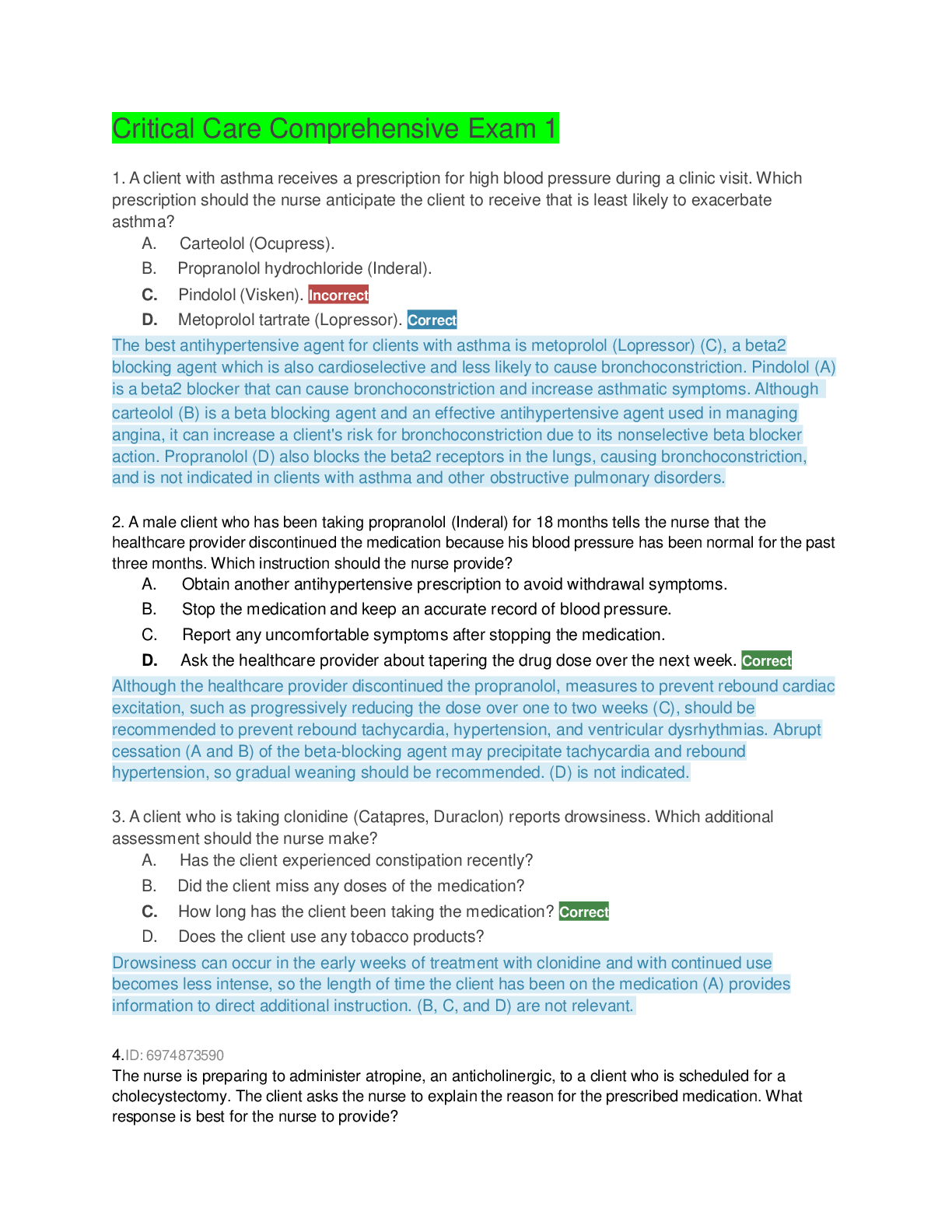
Reviews( 0 )
Document information
Connected school, study & course
About the document
Uploaded On
Jun 07, 2021
Number of pages
39
Written in
Additional information
This document has been written for:
Uploaded
Jun 07, 2021
Downloads
1
Views
52


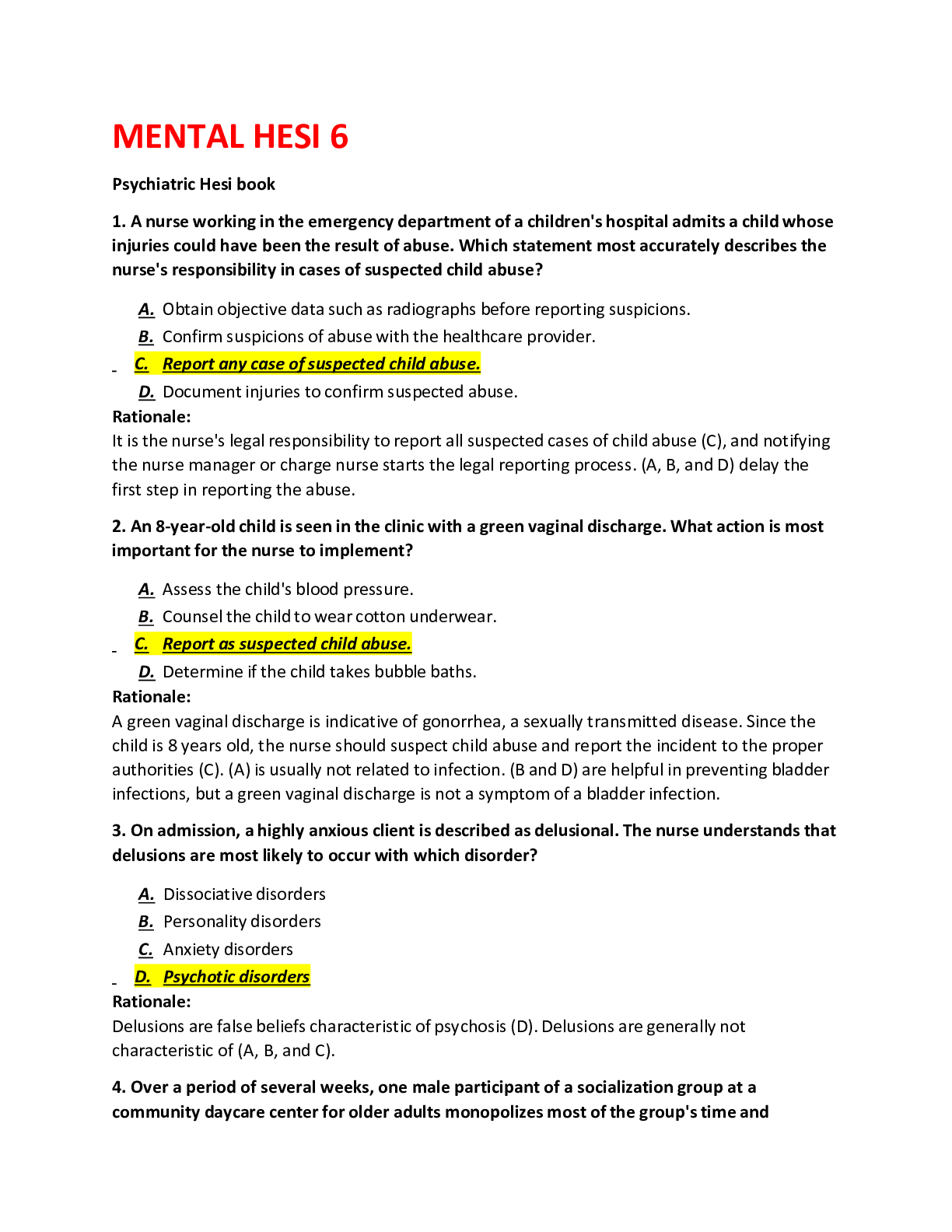
.png)
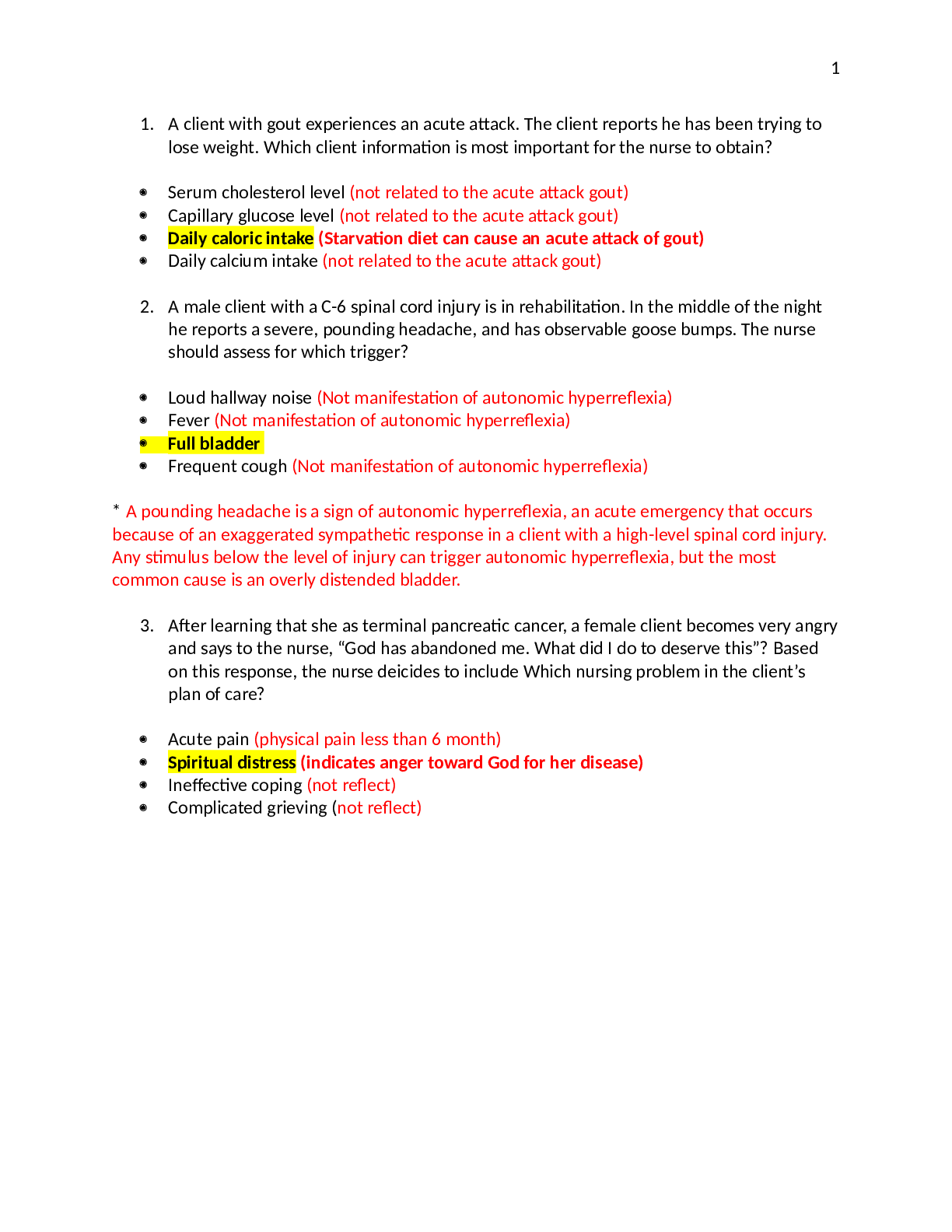
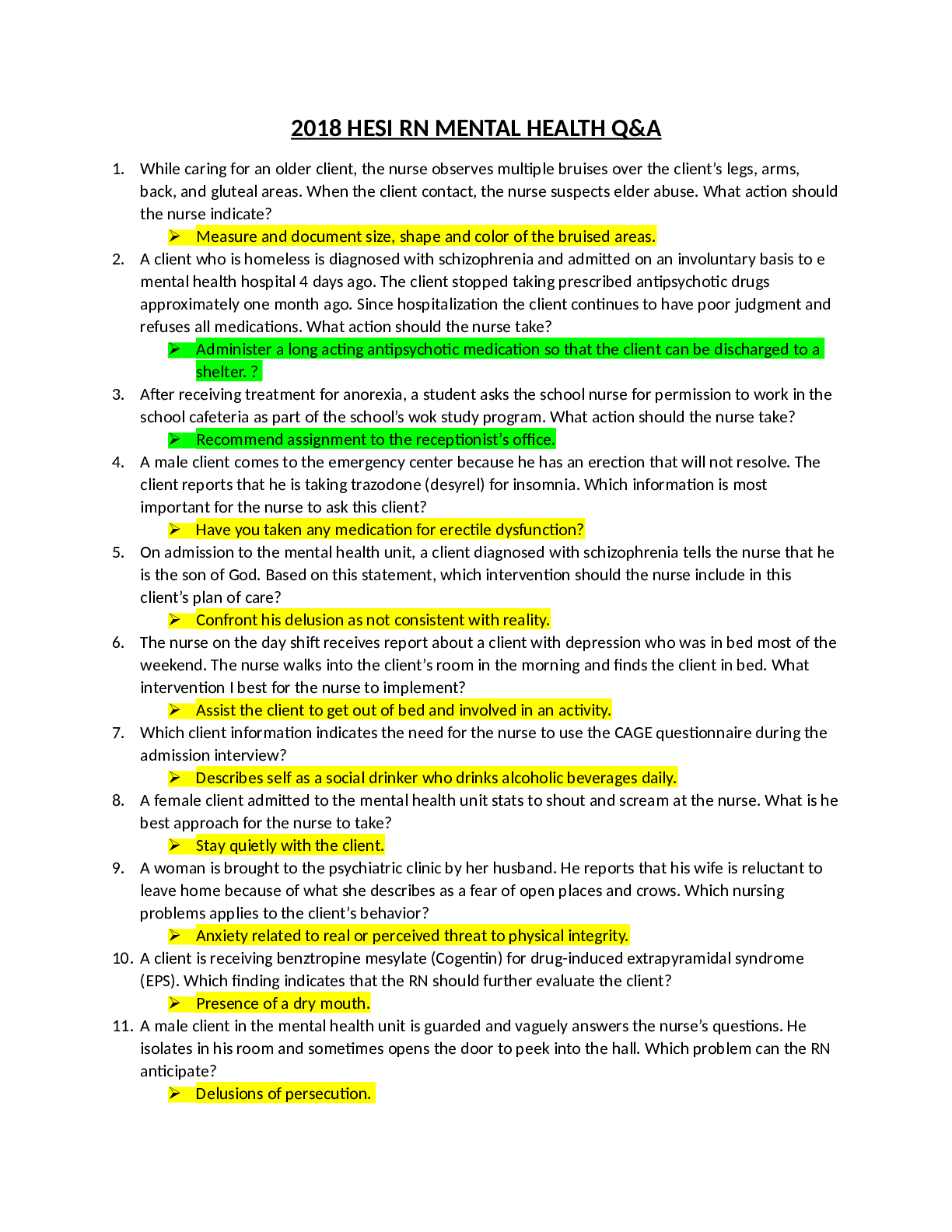
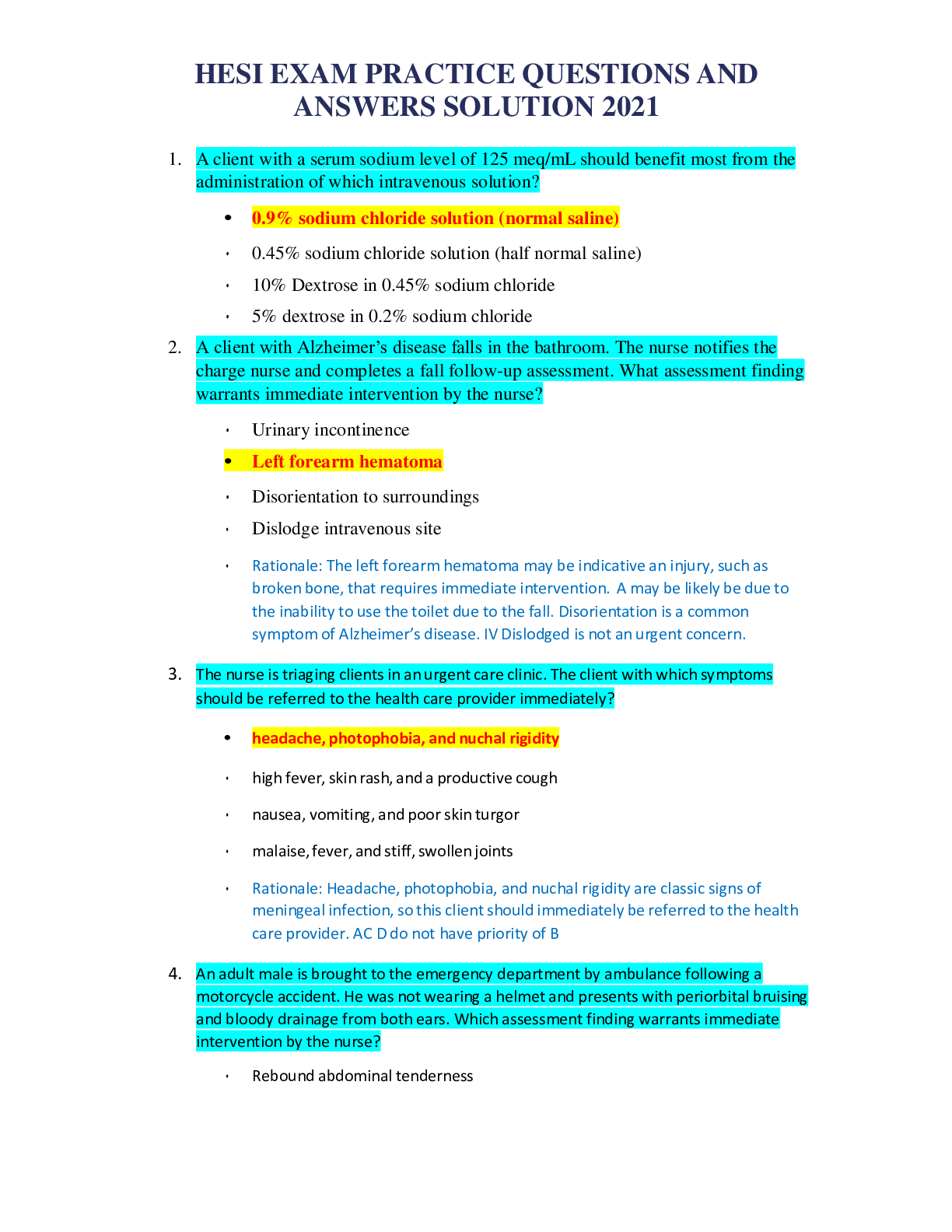
.png)

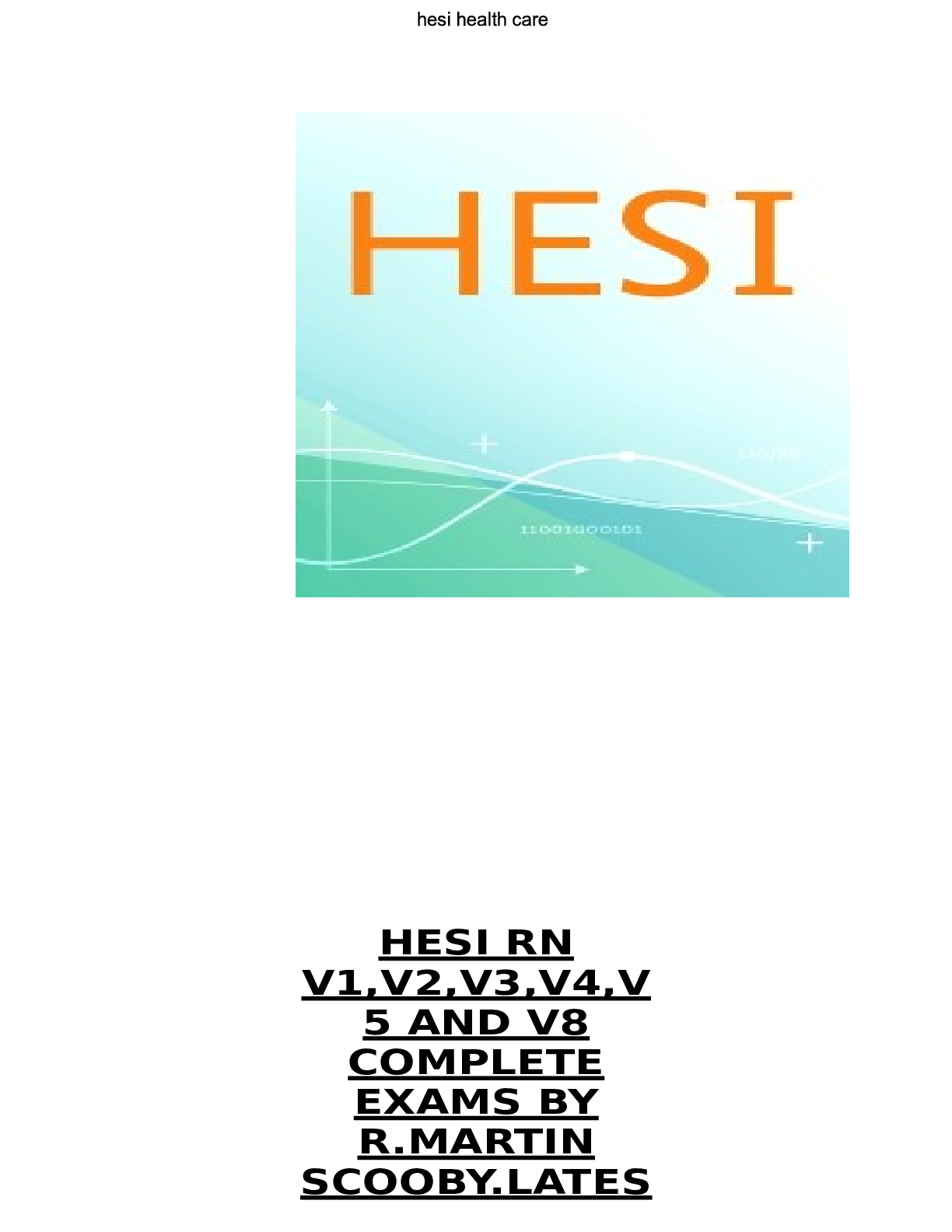
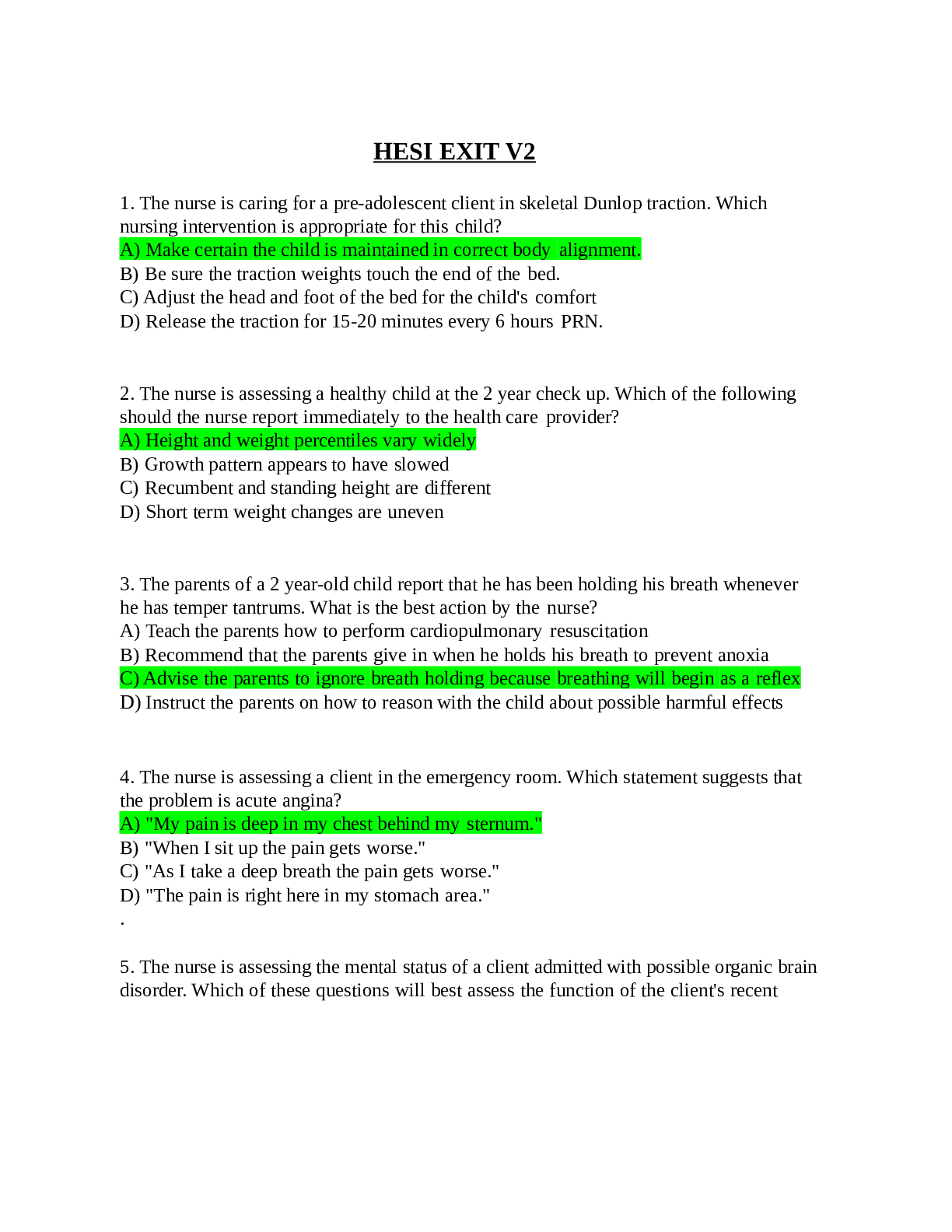
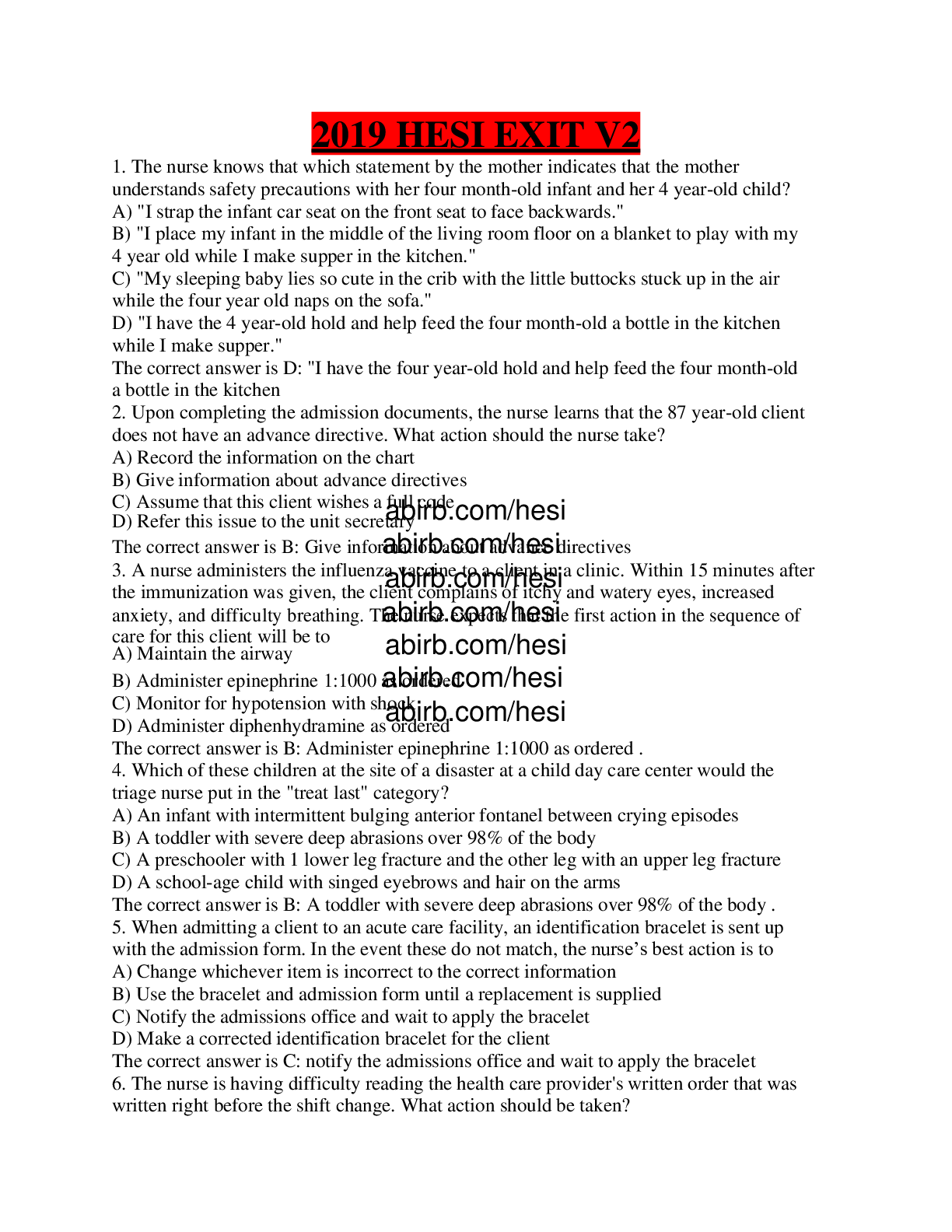
.png)
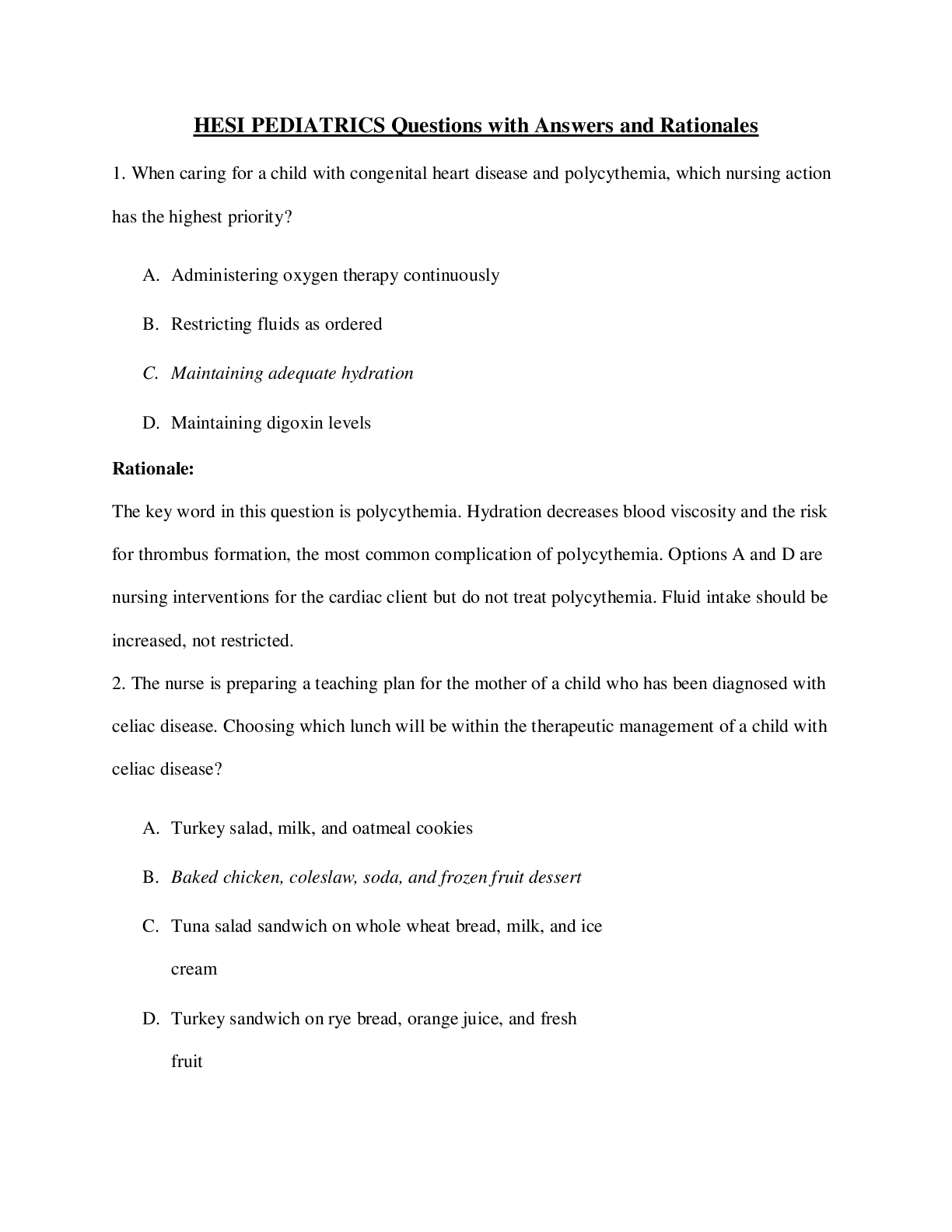
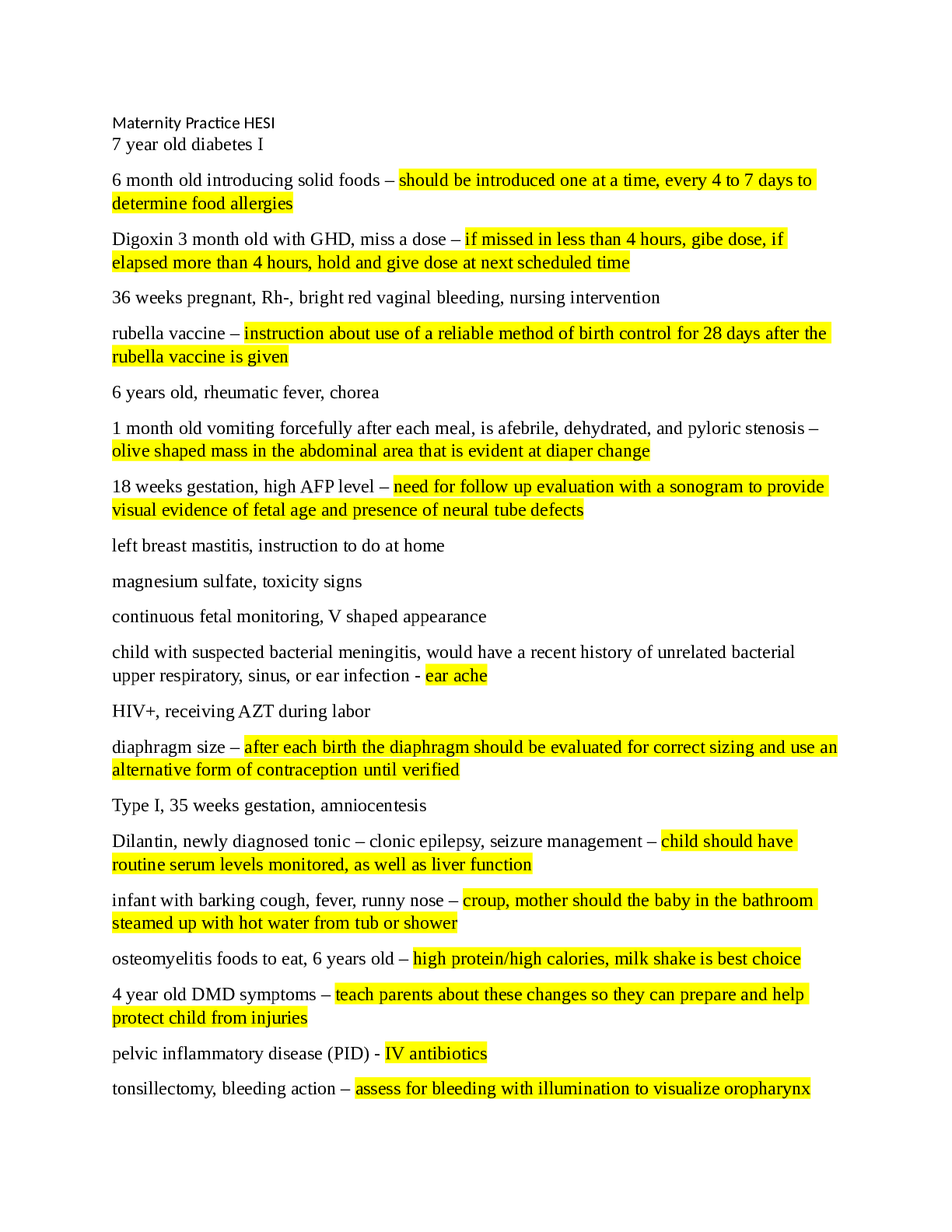
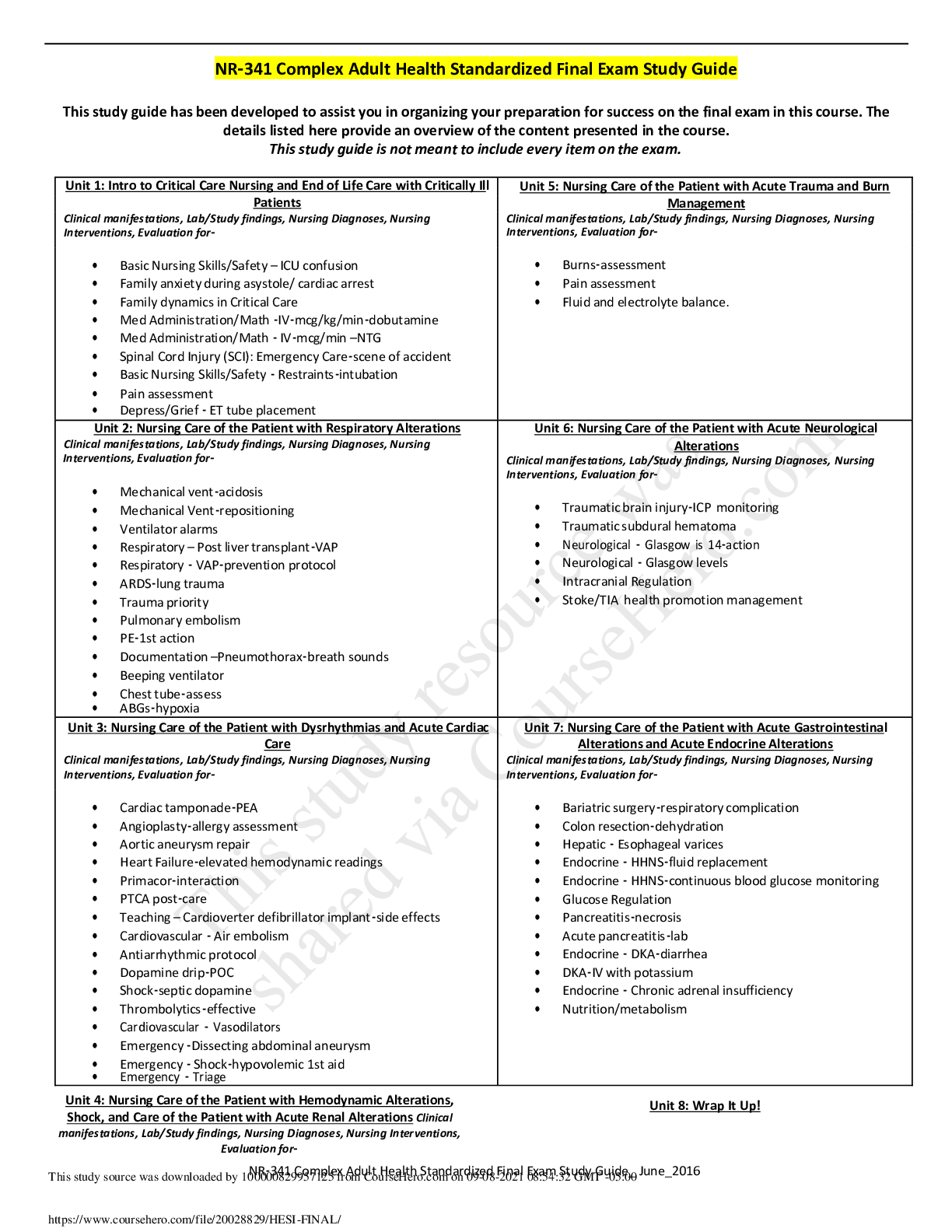

 LATEST QUESTIONS AND COMPLETE SOLUTIONS.png)
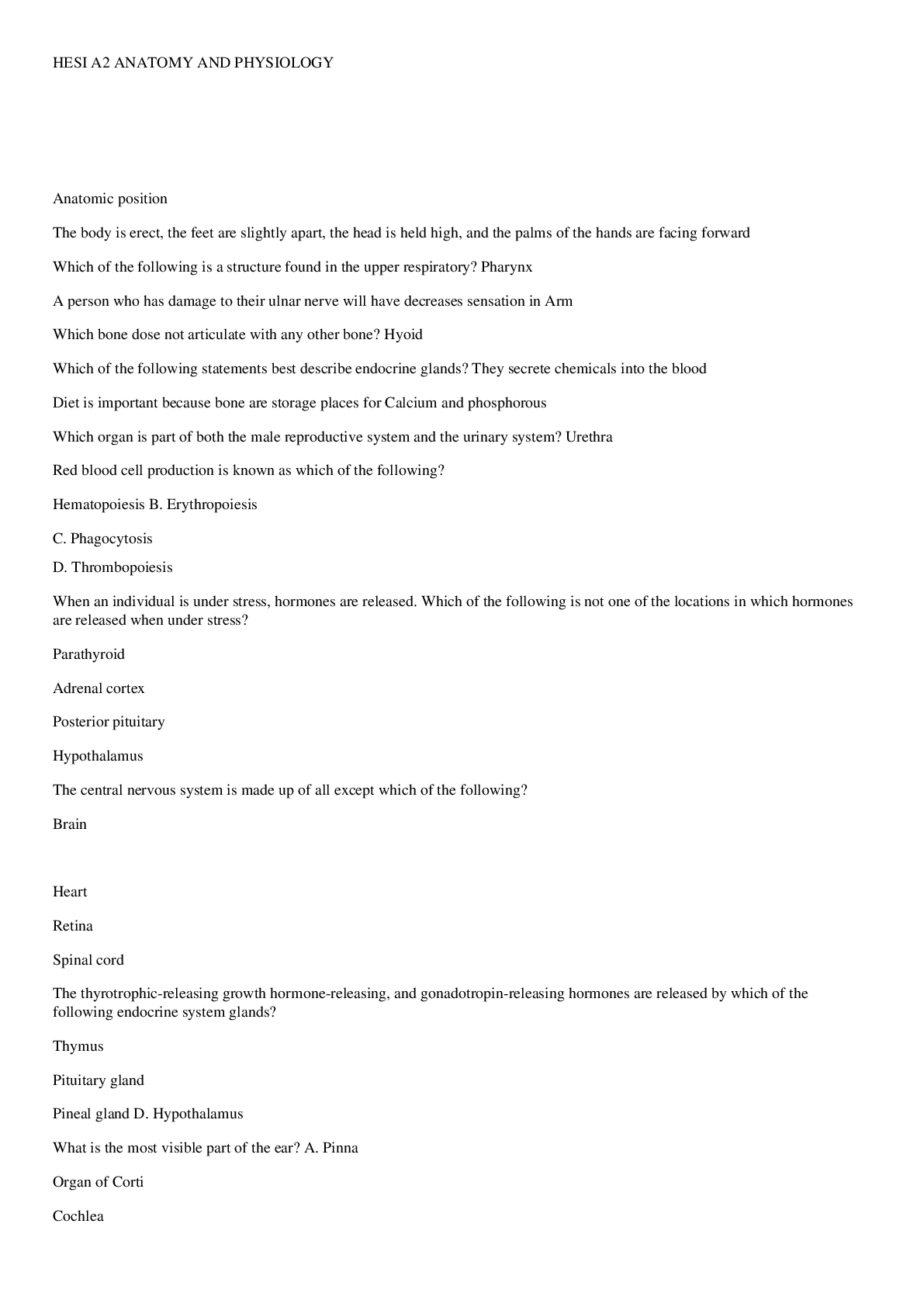
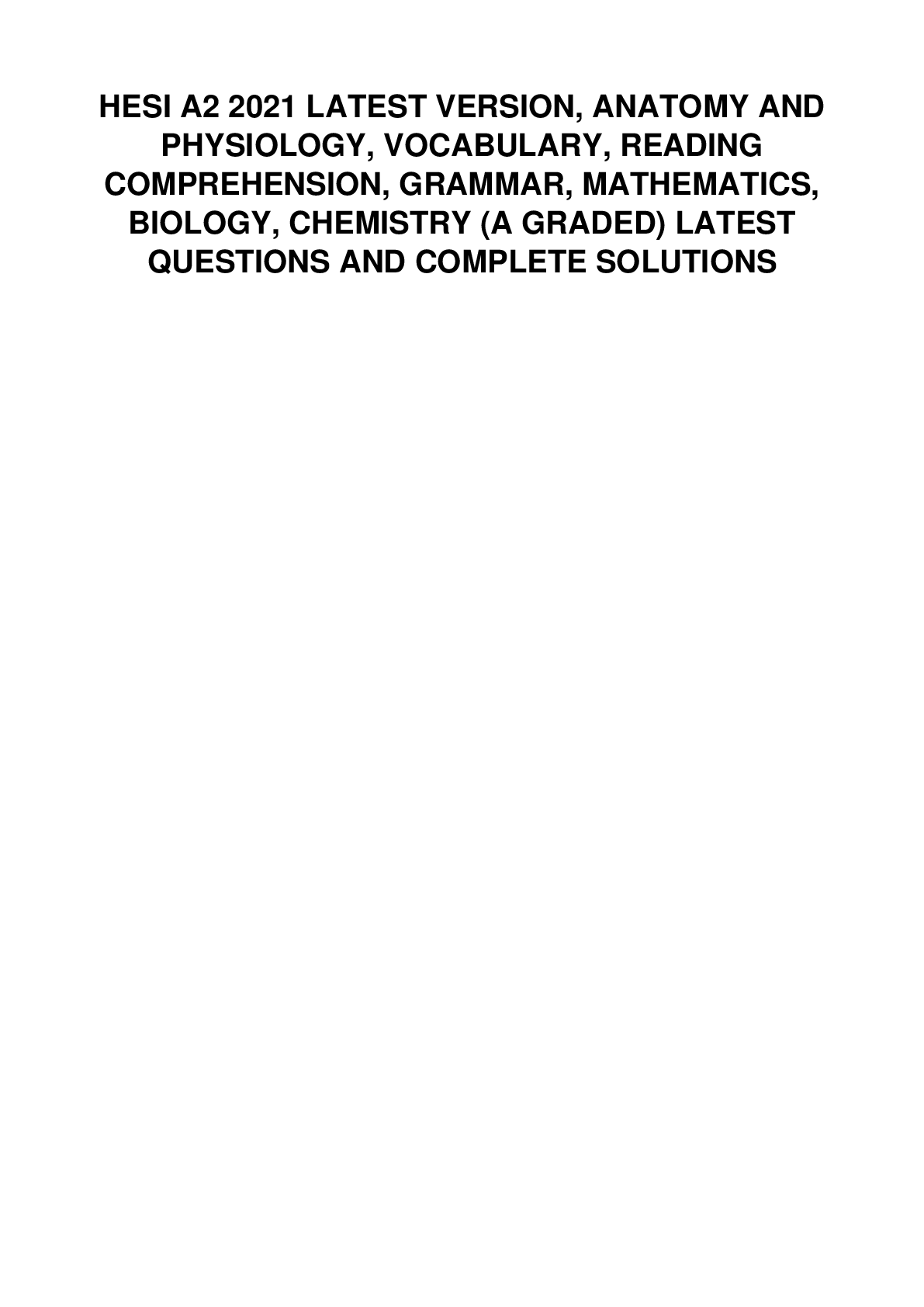
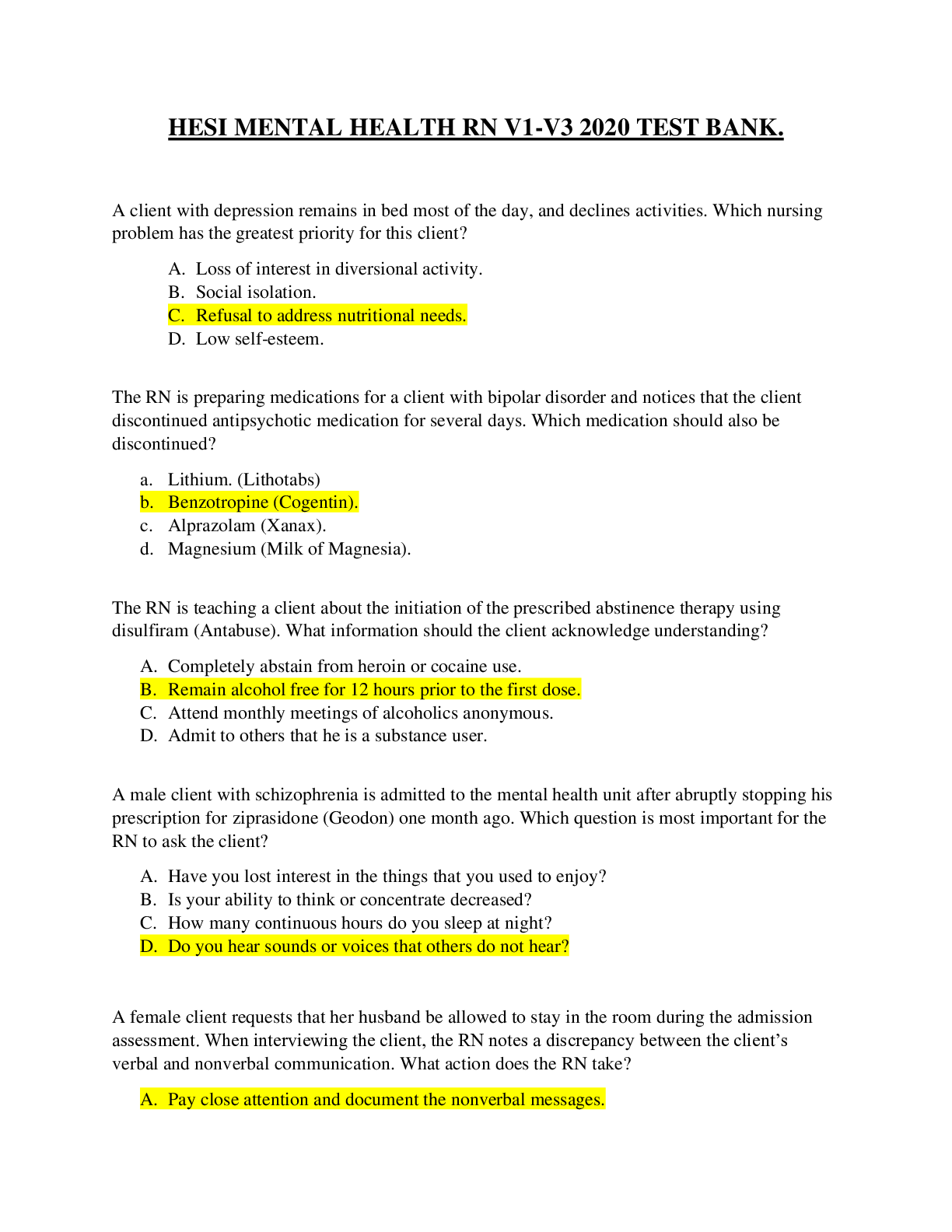
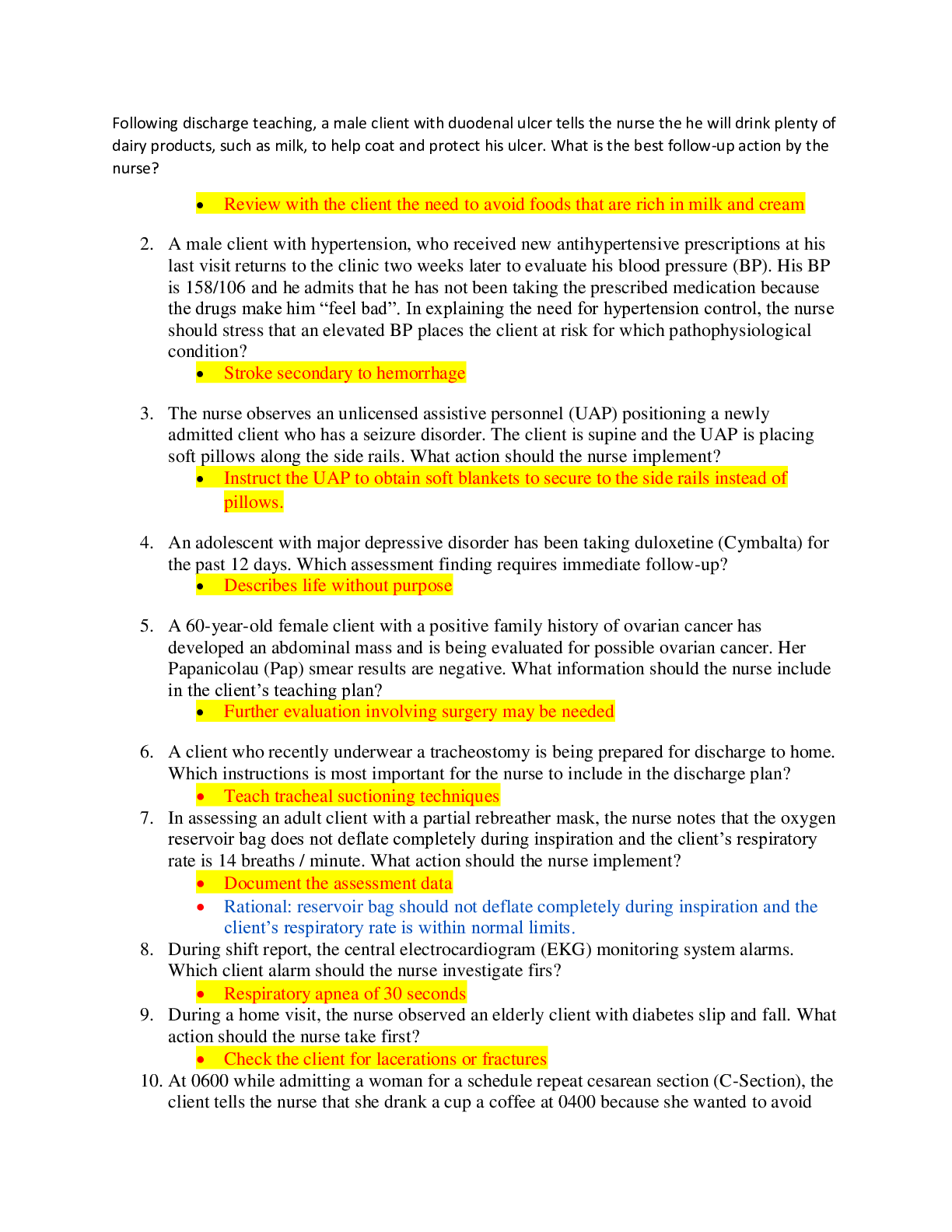

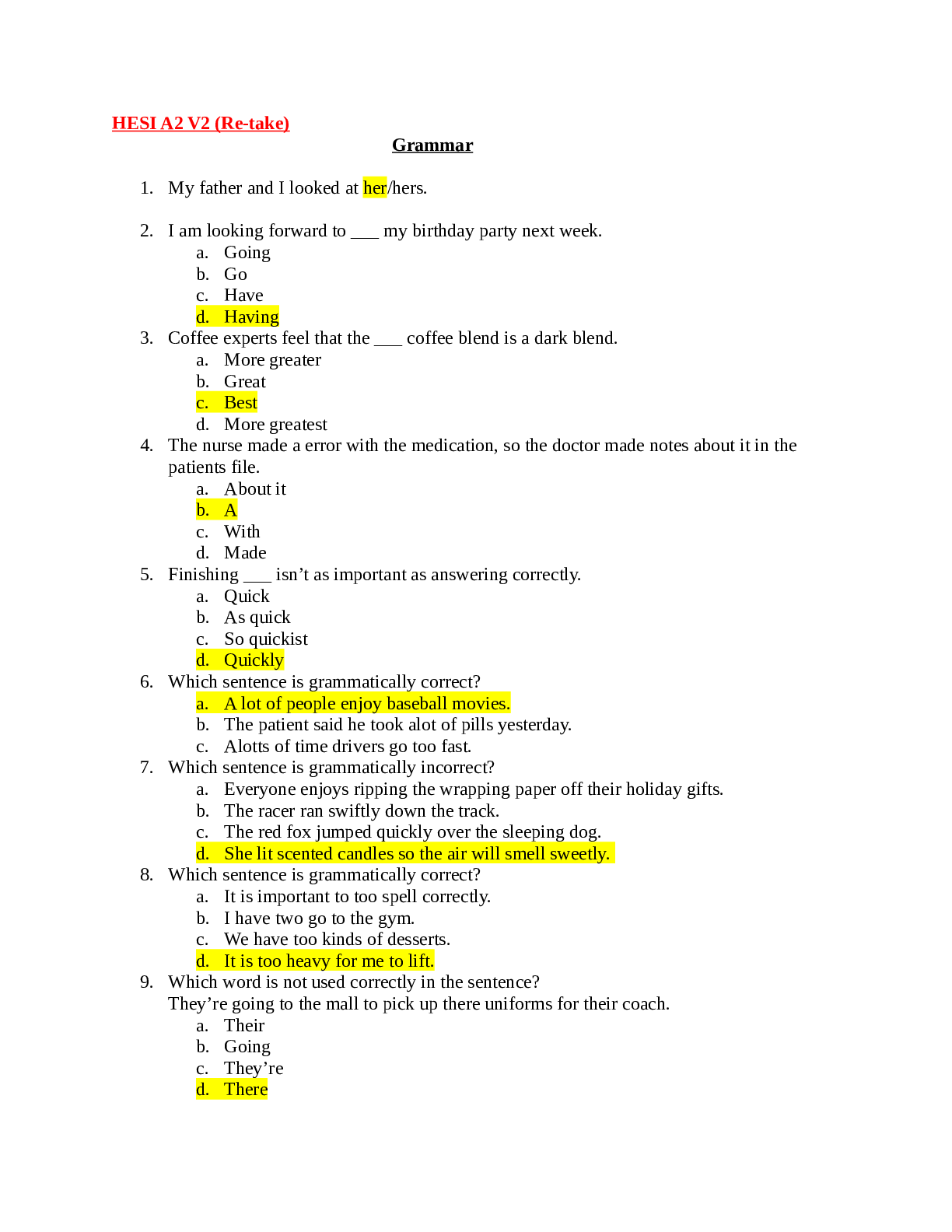

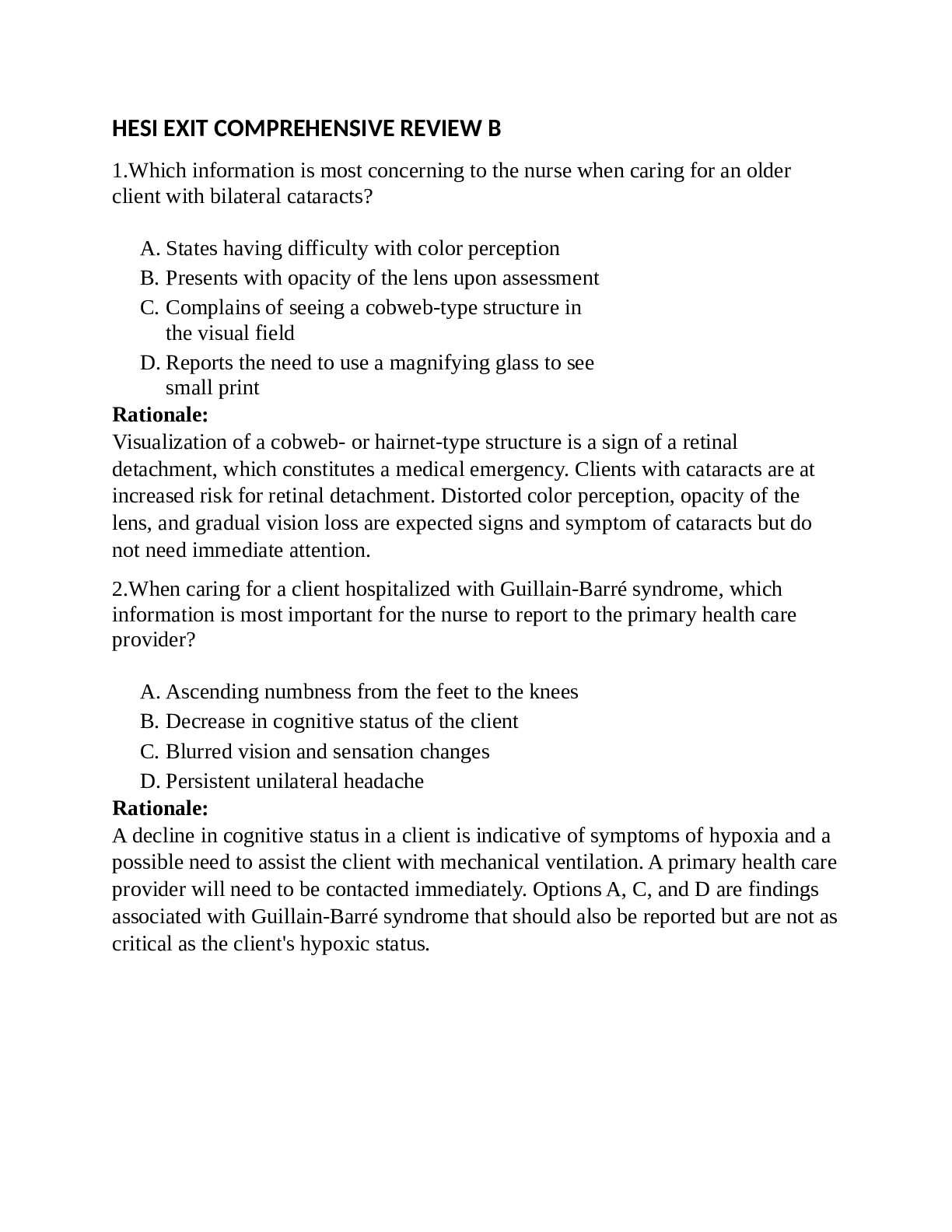
.png)
 Latest Questions and Complete Solutions.png)
 (Latest Update) (A Graded) Latest Questions and Complete Solutions With Explanations.png)
 (A Graded) Latest Questions and Complete Solutions.png)
 (Latest Update) (A Graded) Exam Elaborations Questions and Complete Solutions.png)
 (Latest Update) (A Graded) Exam Test Questions and Complete Solutions.png)

